Fluent Big Inventory Web App
Author:
Fluent Commerce
Changed on:
2 Jan 2025
Overview
The Fluent Big Inventory Web App simplifies inventory management with key features like the Feeds Dashboard, Products, and Inventory sections. Gain real-time insights into feeds, efficiently manage products, and ensure robust inventory control. Whether tracking sources, managing stores, or accessing comprehensive insights, this app delivers a seamless user experience for optimal business value.
Fluent Big Inventory Web App Overview
Author:
Fluent Commerce
Changed on:
6 Jan 2025
Overview
The Fluent Big Inventory Web App is a powerful tool for managing products, inventory, feeds, and sources. Key features include:
- Feeds: View inventory feed details.
- Sources: Track inventory update integrations.
- Products: Manage catalogs and product data.
- Unifies View of Inventory: Gain real-time inventory insights across locations and channels for optimal stock management.
- Inventory: Monitor allocation, SOH, real-time updates, and buffers.
- Stores: Oversee individual and network locations.
- Insights: Track system events.
- Admin: Configure user access and settings.
Key points
- The Fluent Big Inventory Web App offers a comprehensive suite of functionality.
- With dedicated sections for Sources, Products, Inventory, Stores, Insights, and Admin, the web-based interface provides users with a holistic toolset, allowing them to observe and track integrated sources, manage product catalogues, exercise precise control over inventory, oversee individual and networked store locations, monitor system events comprehensively, and efficiently administer the entire inventory availability system for a seamless and valuable user experience.
Product and Inventory Management with Fluent Big Inventory Web App
The Fluent Big Inventory Web App is a web-based interface designed to streamline the management of products, inventory, feeds, and sources. Key functionalities encompass:
- Feeds. The Feeds Dashboard contains general information about inventory feeds for an account.
- Sources. The inventory data sources allow users to observe and track integrated inventory update sources.
- Products. The products section allows a user to manage product catalogs and products.
- Unified View of Inventory (UVOI). This section provides a consolidated view of inventory across locations and sales channels, offering real-time data to optimize stock levels, improve inventory allocation, and enhance fulfillment efficiency.
- Inventory. The Inventory section provides robust inventory management, including visibility of allocation, stock on hand (SOH) for specific items, real-time inventory status, available-to-promise levels, and inventory buffers to prevent overselling.
- Stores. The stores section allows you to manage individual locations and networks of locations.
- Insights. The insights section provides comprehensive details on monitoring all the system events that have occurred.
- Admin. The admin section provides administrative capabilities to manage the system and users.
Each section contributes essential reference capabilities integrated into the Fluent Big Inventory Web App to offer an unparalleled user experience and deliver value across diverse business scenarios.
Value Proposition
Implementing the Fluent Big Inventory Web App has the following benefits:
- View statistics and metrics about inventory feeds and inventory updates
- View product and inventory details and change buffer or safety stock values
- Manage and edit Product Catalogues, Inventory Catalogues, Virtual Catalogues, and Control Groups
- Manage users and settings
Fluent Big Inventory is an application, powered by our UX framework. The UX framework allows our Customers and Partners to easily configure or extend each feature to match their business needs.
Features
Inventory Update Overview
Inventory Update Overview provides a comprehensive dashboard view of the inventory management system. Users can track the following data:
- number of updates that have encountered failures from each source system;
- time elapsed since the last update was received from each source system;
- total number of inventory updates received from each source system over the past 24 hours;
- estimated processing time for a newly submitted inventory update.
Feeds Insights
Feeds Insights provides users with a comprehensive dashboard view of their inventory feeds over the past 24 hours.
Product Management
Product Management is where users can manage everything related to their product SKUs. It encompasses the management of Product Catalogues, Products, and Categories.
Unified View of Inventory
The Unified View of Inventory (UVOI) centralizes inventory data from all locations and sources into a single, real-time view. This feature empowers inventory managers, store associates, and eCommerce teams to monitor stock levels, reduce inefficiencies, and address operational challenges quickly. The UVOI supports smarter decision-making and seamless inventory operations by providing a holistic view and actionable data.
Inventory Management
Inventory management provides a comprehensive range of capabilities. Users can oversee inventory visibility, allocation, stock quantity (Stock on Hand—SOH), and status, gain insights into available-to-promise inventory levels, and strategically employ inventory buffers to prevent product overselling. Read more about Inventory management capabilities.
Admin Management
The Admin user interface in the Fluent Big Inventory Web App offers a suite of administrative features to manage the system efficiently:
- Manage the users with access to your Fluent Big Inventory Accounts;
- Manage the roles and permissions to precisely control how many of your Accounts each user can access;
- Customise application settings to control the operation of your Fluent Account to align with your business needs.
Further Reading
- Learn how to get started configuring the Fluent Big Inventory Web App
- Learn how to extend the Fluent Big Inventory Web App
Related content
Sources Dashboard
Author:
Fluent Commerce
Changed on:
1 Mar 2024
Overview
The Sources Dashboard allows customers to understand the current state of Inventory Ingestion within their account. Customers can understand how their inventory is processed and monitor the execution flow in real time.
The Sources Dashboard visualizes inventory metrics and displays user-friendly information by querying inventory-related metrics data.
The data is presented for up to the last 24 hours. You can read more about how to configure periods in the guide.
The Sources Dashboard contains Overview and Sources sections.
Key points
- The Sources Dashboard offers a real-time window into Inventory Ingestion, allowing customers to monitor the execution flow and comprehend the current status of their inventory.
- With user-friendly visualizations and configurable time periods, the Sources Dashboard empowers users to access comprehensive inventory metrics data, enhancing their ability to make informed decisions about inventory processing.
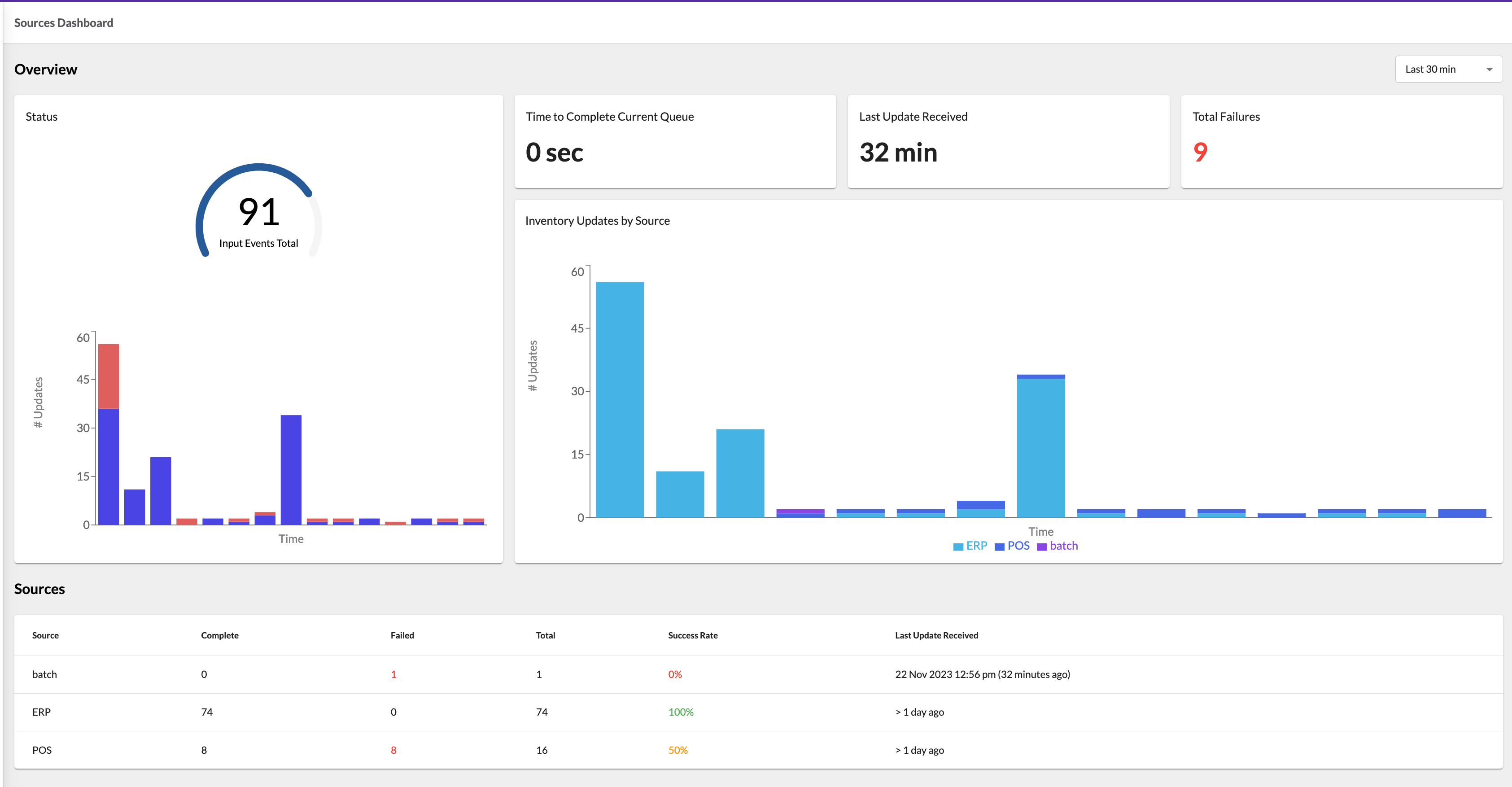
Overview Section
The Overview section contains five cards: Status, Time to Complete Current Queue, Last Update Received, Total Failures, and Inventory Update by Source.
The Status card displays inventory events data for a selected period. The data is presented in 2 charts:
The gauge chart displays the total number of events for the selected period. The chart supports colored thresholds configured via a setting. Read more about colored thresholds in this guide.
The bar chart shows the same data as a gauge chart but is divided by minutes. The chart includes failures, represented with split colors for clarity.
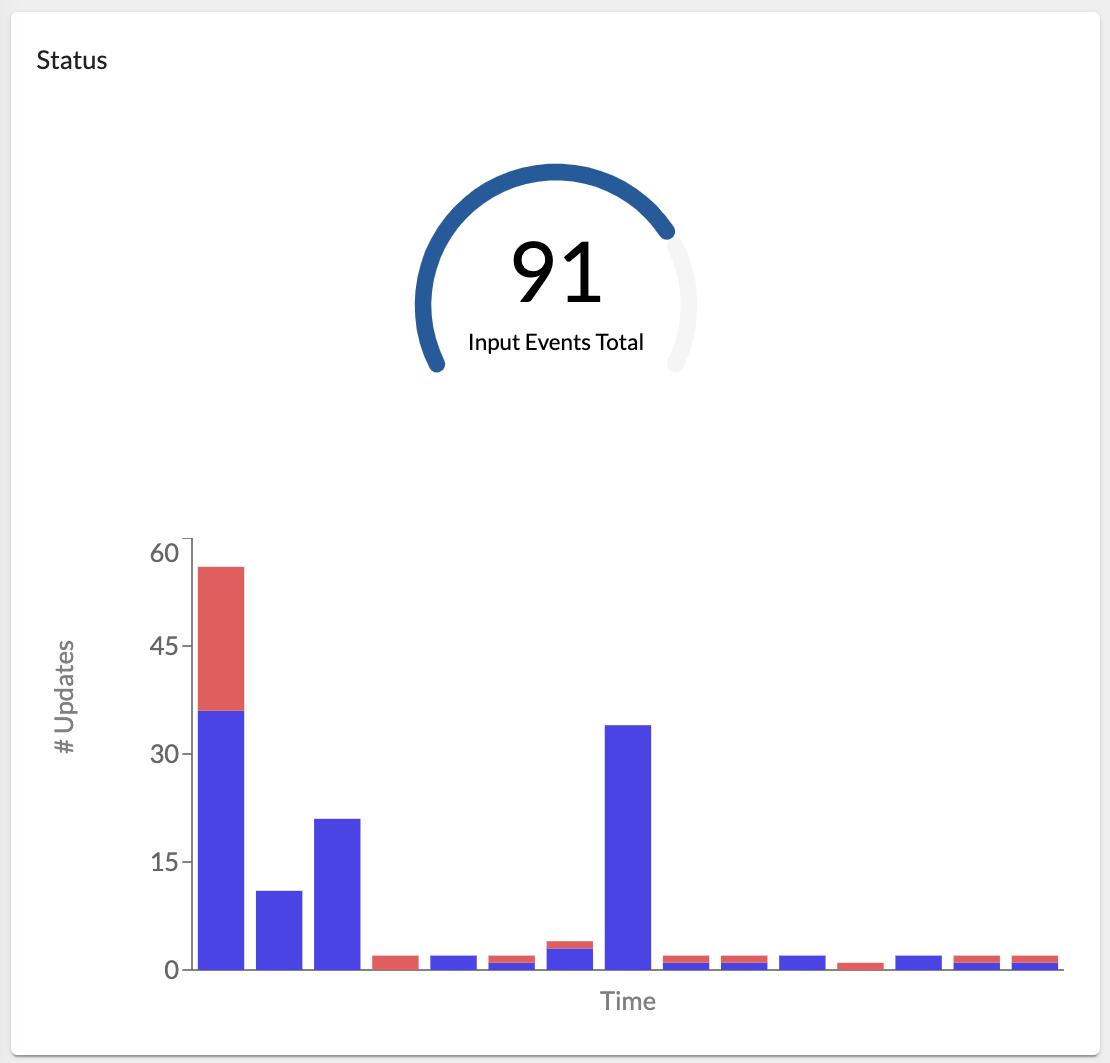
The Time to Complete Current Queue card displays the estimated time required to complete the current queue of updates.

The Last Update Received card displays the time since the last inventory update event was received.

The Total Failures card displays an aggregated number of the Inventory problems or anomalies based on the Metrics data for a selected period.
The Total Failures value is clickable, redirecting to the Events page pre-filtered to enable users to identify the specific Inventory Events that have failed.
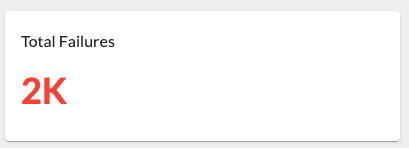
The Inventory Update by Source card displays inventory event data for a selected period divided by sources.
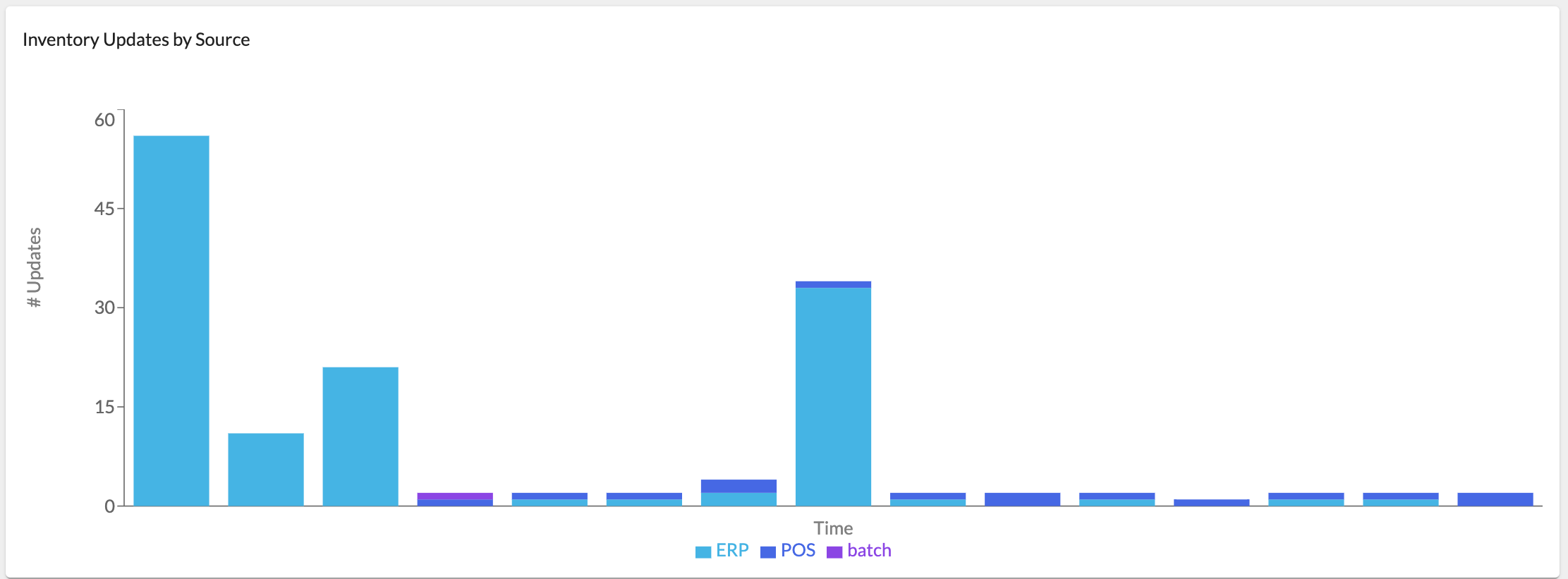
Sources Section
Inventory-related metrics data represents events by different sources (e.g., batch, ERP, POS, etc.). The source is an event attribute.
The Sources section contains a table with the listed inventory sources. The table displays the following information:
- Source - The source system that submitted an inventory update event;
- Complete - The number of successfully completed inventory updates (all statuses except and
`FAILED`);`NO_MATCH` - Failed - The number of inventory updates with and
`FAILED`statuses;`NO_MATCH` - Total - The total number of Inventory updates of a particular source;
- Success Rate - A rate calculated by formula: (complete inventory updates / total inventory updates) * 100% ;
- Last Update Received - The last inventory update. If the last update was too long ago (more than 24 hours) or not returned,"> 1 day ago" is displayed in the column.

Related content
Feeds Dashboards
Author:
Fluent Commerce
Changed on:
8 Feb 2024
Overview
The Feeds Dashboard contains general information about inventory feeds for an account for the selected periods (default periods are: last 30 minutes, last 1 hour, last 8 hours, last 24 hours). You can read more about how to configure periods in this guide.
The Feeds Dashboard contains Overview and Feeds sections.
Key points
- You should know about Inventory Feeds.
- The Feeds Dashboard offers a comprehensive overview of inventory feeds, presenting general information for selected periods and providing users with insights into their account's feed activities.
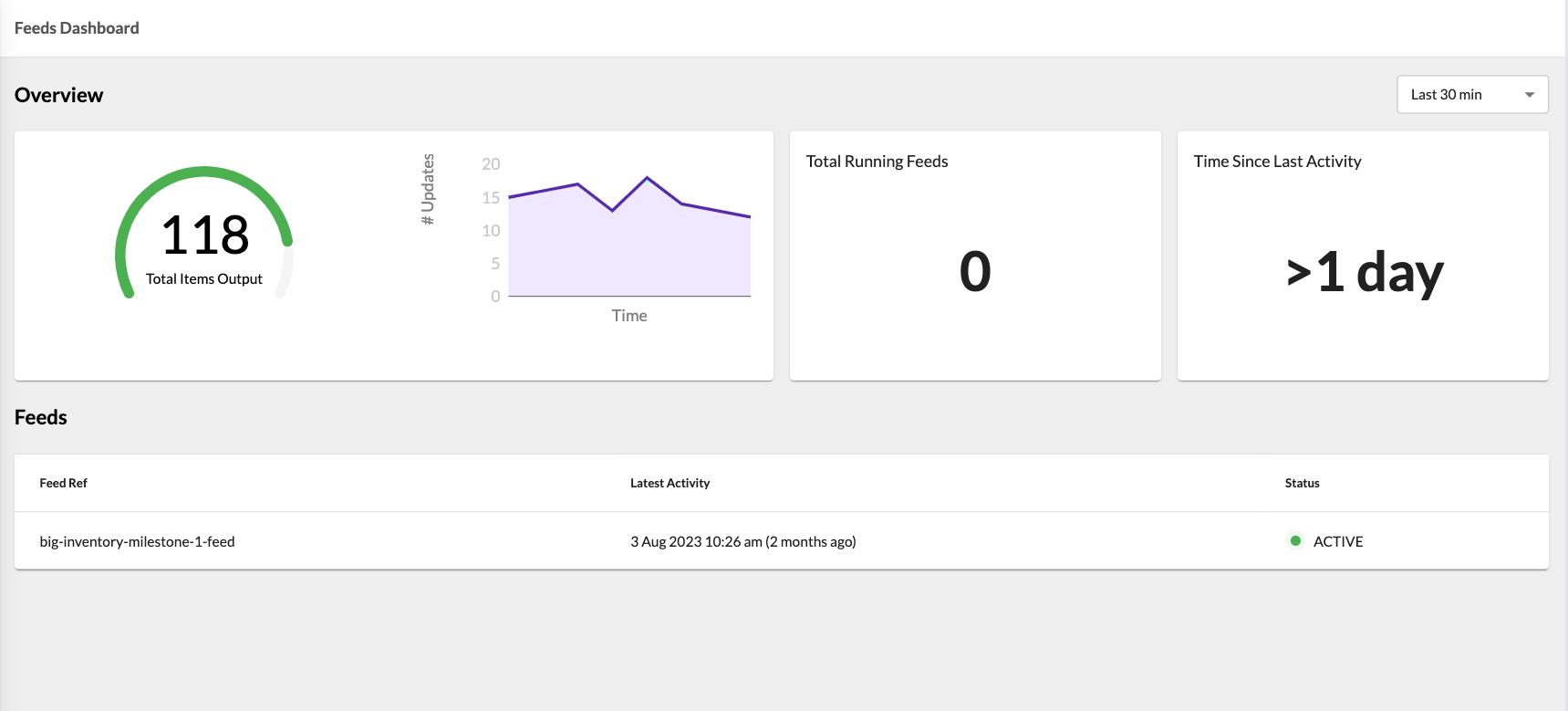
Overview
The Overview section contains three cards: Output Volume, Total Running Feeds, and Time Since Last Activity.
The Output Volume card displays the number of records in the inventory feed for a selected period. The data is presented in 2 charts:
The gauge chart shows the total items output for a set period. The chart supports colored thresholds configured via a setting. Read more about colored thresholds In this guide.
The area chart displays the same data as a gauge chart divided by minutes, e.g., in the last 30 minutes, the feed has run ten times, and the chart displays the number of records in each feed.
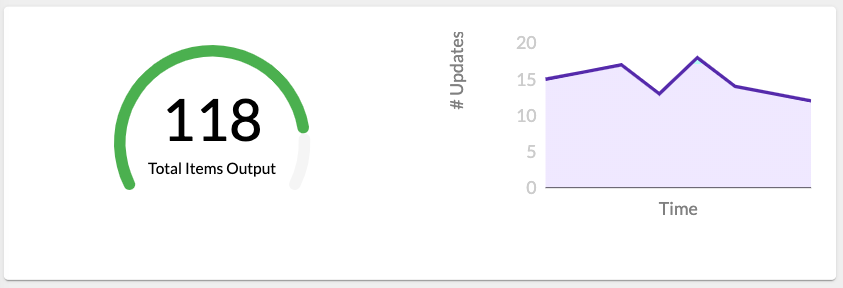
The Total Running Feeds card displays the number of feeds running now. In case there is no running feed, 0 is shown.
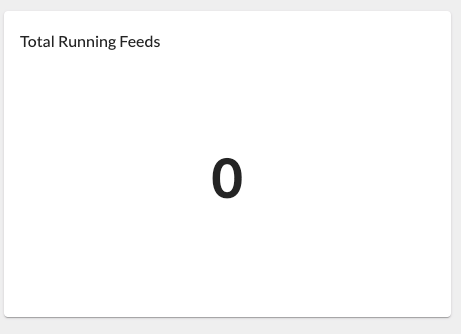
The Time Since Last Activity card displays how long since a feed last finished.
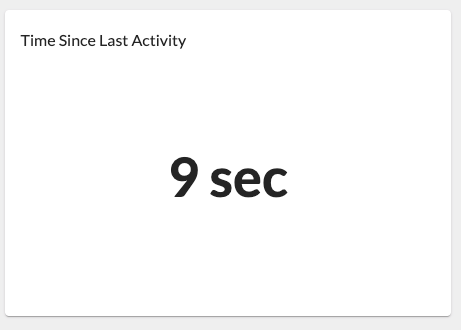
Feeds Section
The Feeds section contains a table with a list of all inventory feeds. The table displays the following information: Feed Ref, Latest Activity, and Status (Active or Inactive).

Products
Author:
Fluent Commerce
Changed on:
8 Feb 2024
Overview
The Product module is a collection of products and any attributes and details associated with each product in the category.
The Products module of the Fluent Big Inventory app provides comprehensive capabilities:
- Product Catalogue management
- Standard and Variant Product management
- Category management
The module contains the following configurations:
- Categories
- Product Catalogues
Key points
- The Products module within the Fluent Big Inventory app is a centralized hub for managing a collection of products, encompassing all associated attributes and details, offering a holistic approach to product management.
- The module focuses on Product Catalogue management, Standard Product management, and Category management. It empowers users to organize and oversee their product-related information efficiently, providing a seamless and comprehensive solution.
- The module offers specific configurations for managing Categories and Product Catalogues, ensuring a tailored and effective approach to product categorization and cataloguing.
Features
The Products module provides several features that allow management of products efficiently.
Manage Product Catalogues
The Products module allows users to create and manage product catalogues.
For more details about the specifics of creating and editing Product Catalogues, check out the following guide:
Categories
Products can be associated with categories and sub-categories.
The Categories page displays the list of all available categories. Clicking
`Ref`The detail view consists of the following tabs:
- Details
- Attributes
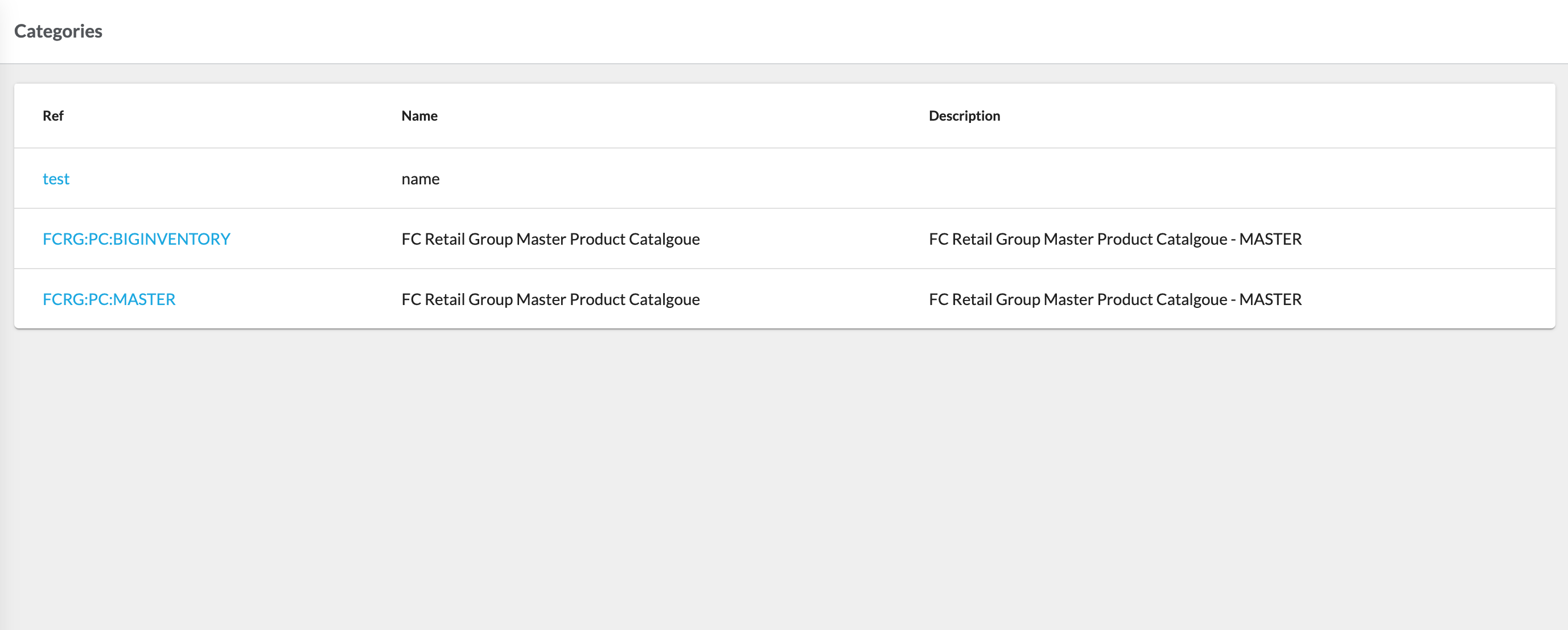
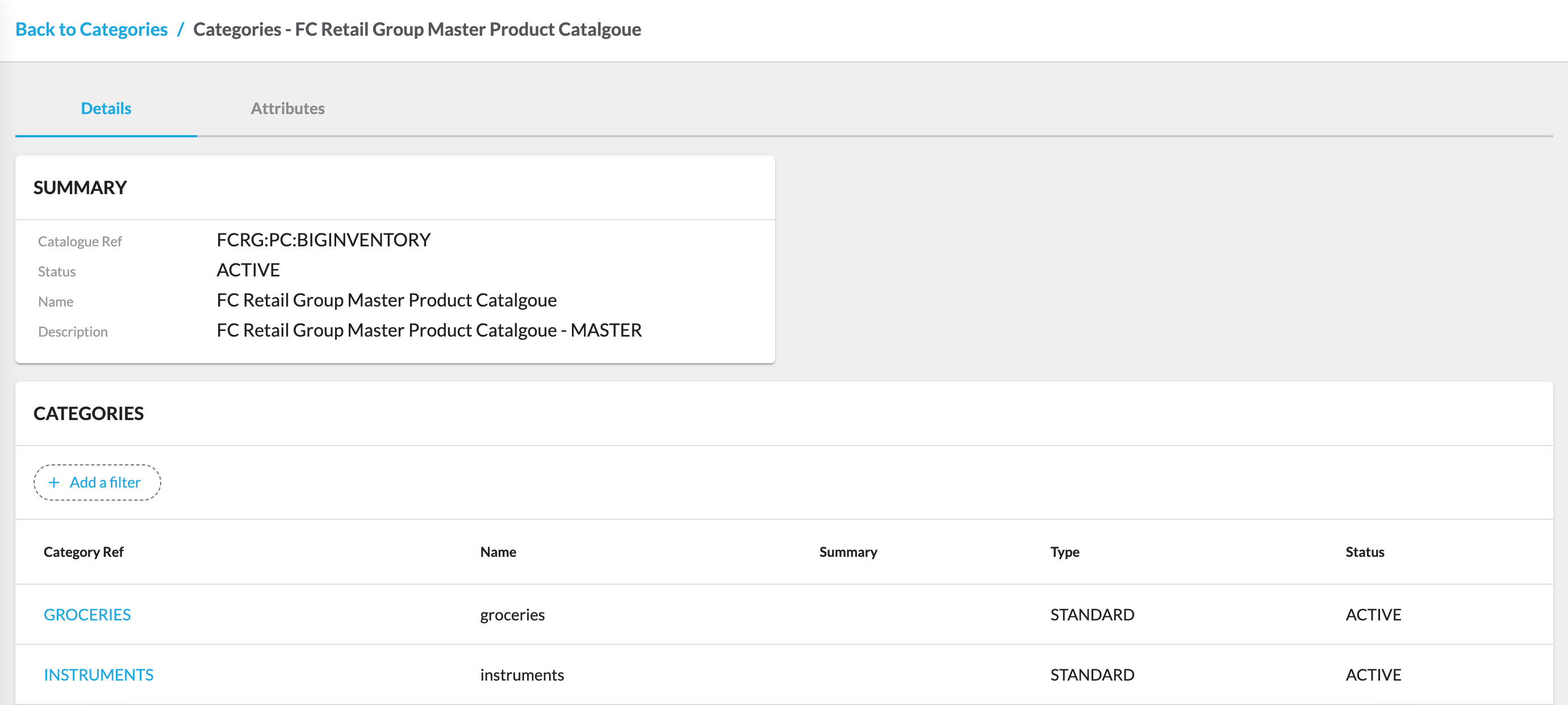
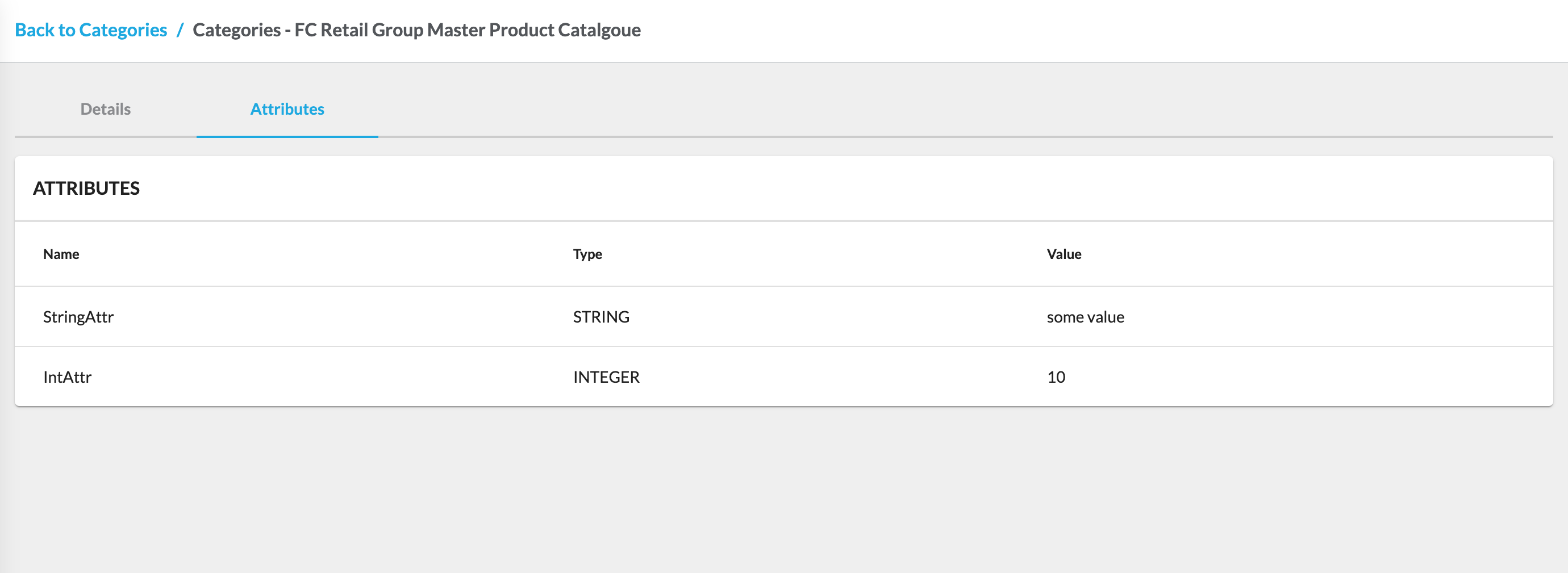
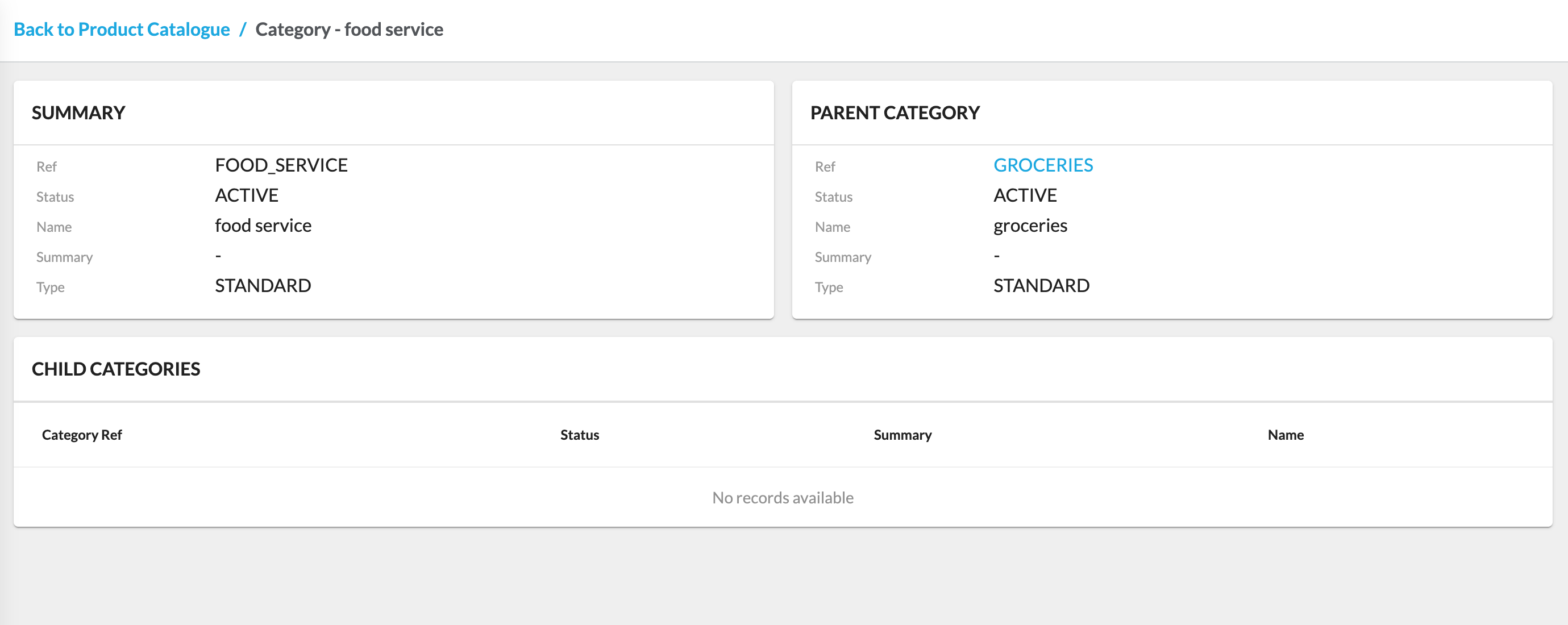
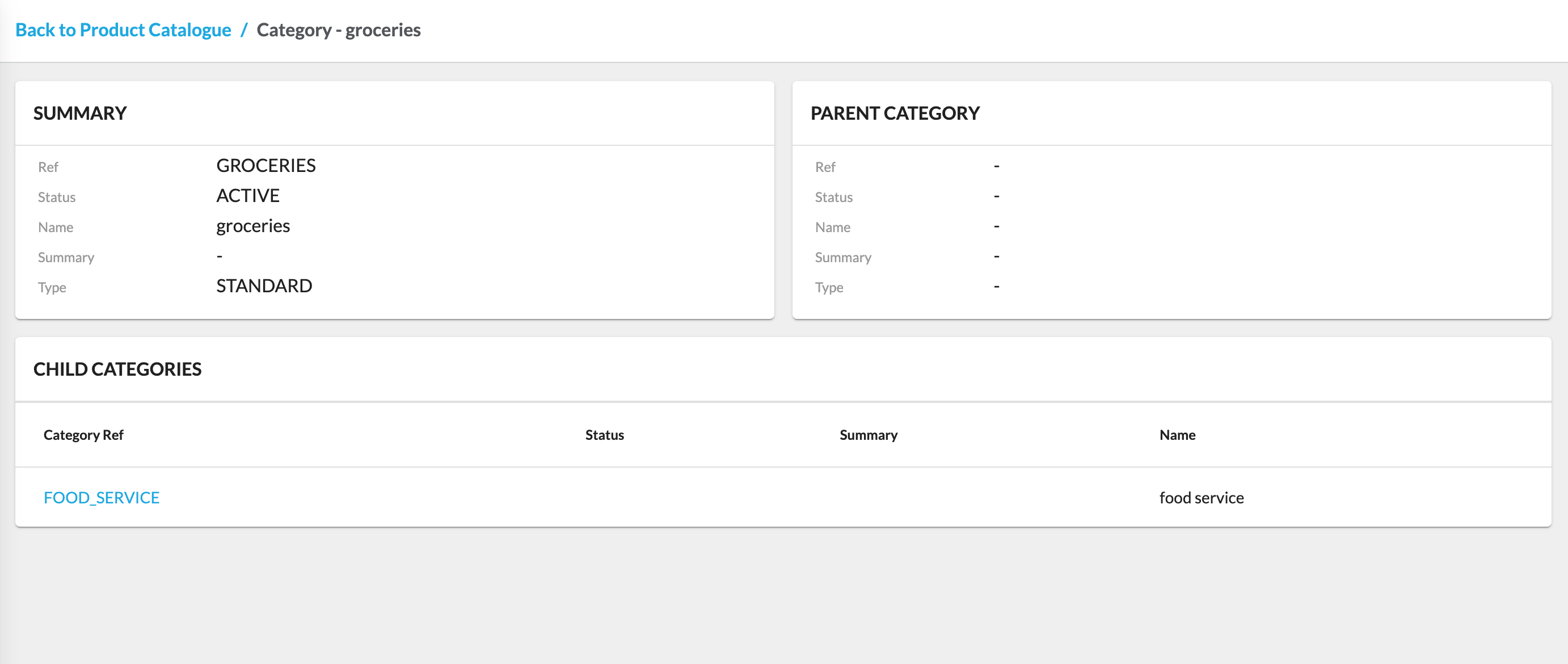
Product Catalogues
A 'Product Catalogue' stores all the Products a retailer wants to sell and contains information that helps identify each product (e.g., name, color, description, product code).
A retailer can have one or more Product Catalogues containing all their products. Each Product Catalogue type has a corresponding workflow, referred to as 'Product Catalogue Workflow', used to orchestrate products in the Product Catalogue. The retailer can configure workflows to add their specific business logic.
Product Catalogue Entities
- Standard Product
- A standard product entity. It includes:
- a sellable, non-variant product
- a non-sellable base for a variant product
- a sellable or non-sellable component of a group product
- A standard product entity. It includes:
- Variant Product
- An entity that holds additional attributes for variation of a base product such as size, color, volume, etc. The base product is non-sellable and stored as a Standard Product.
The Product Catalogues configuration displays the list of all available product catalogues. Clicking
`Ref`The detail view consists of the following tabs:
- Details
- Categories
- Attributes
- Activity
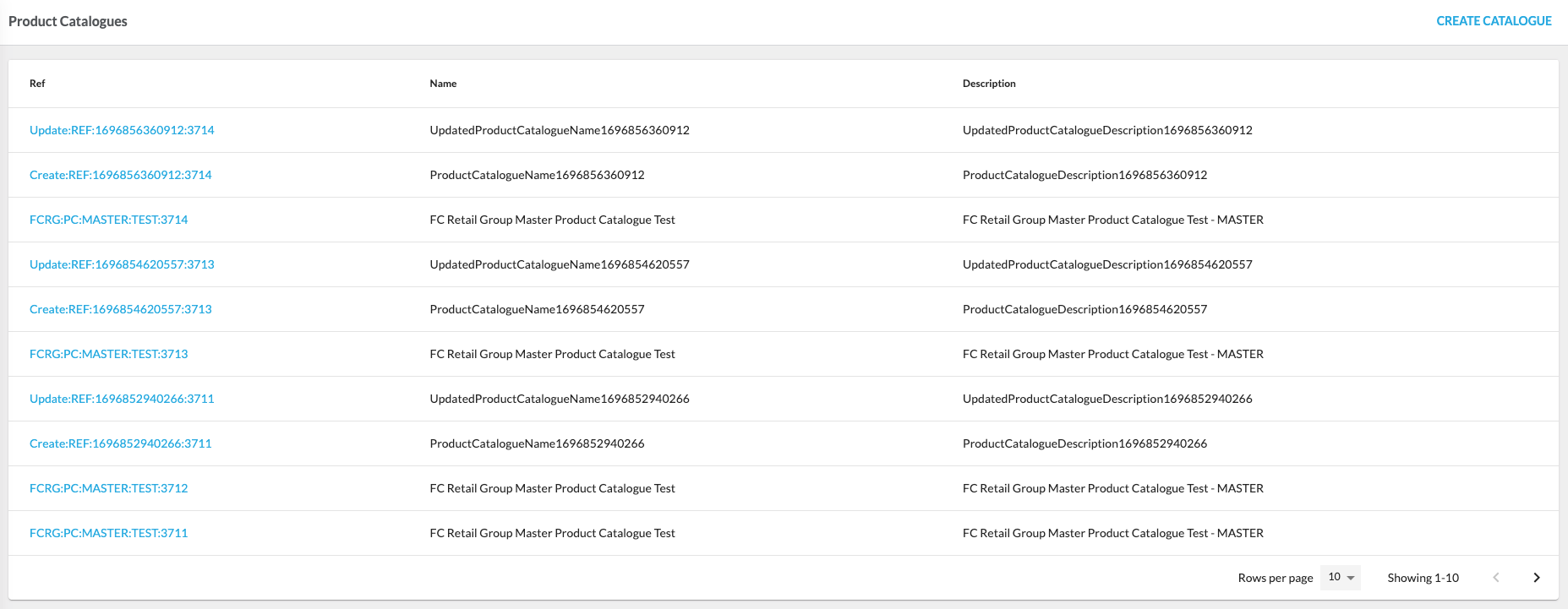
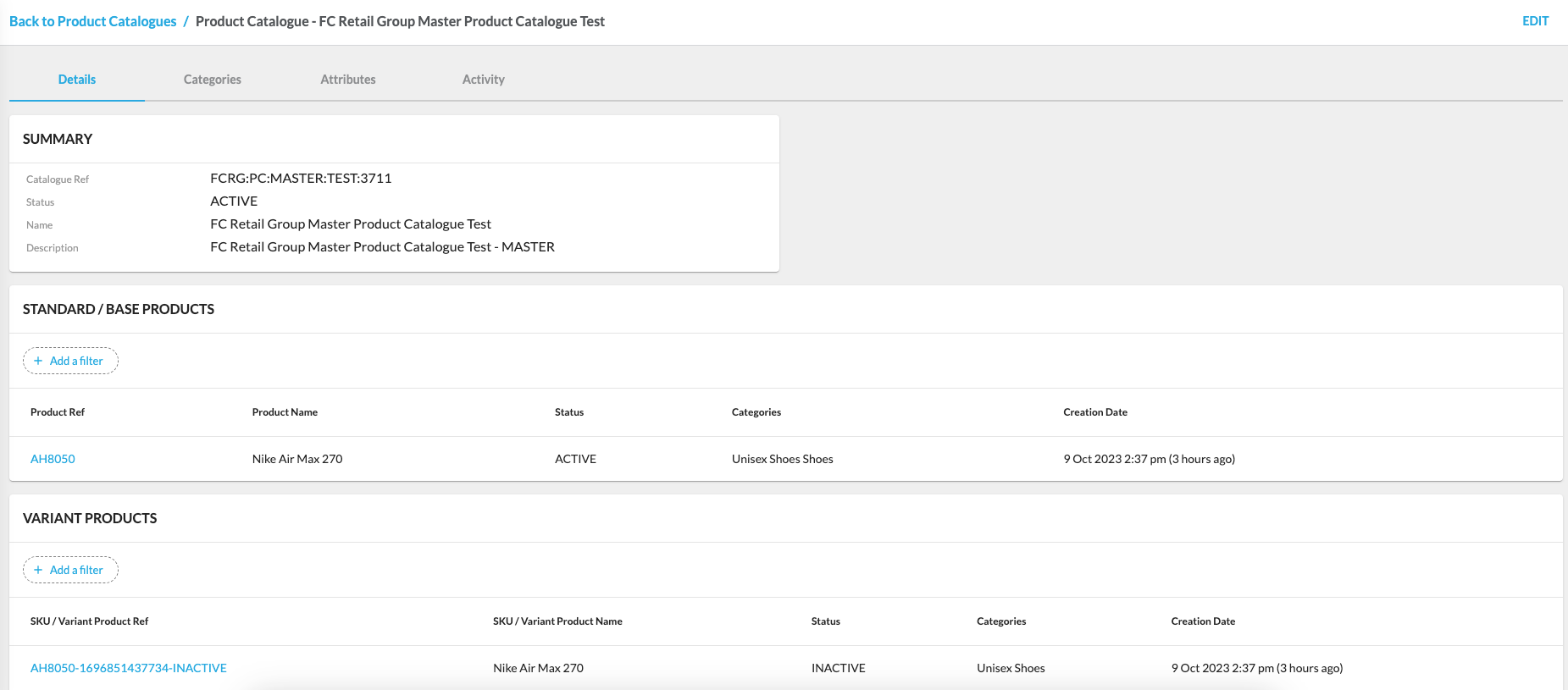


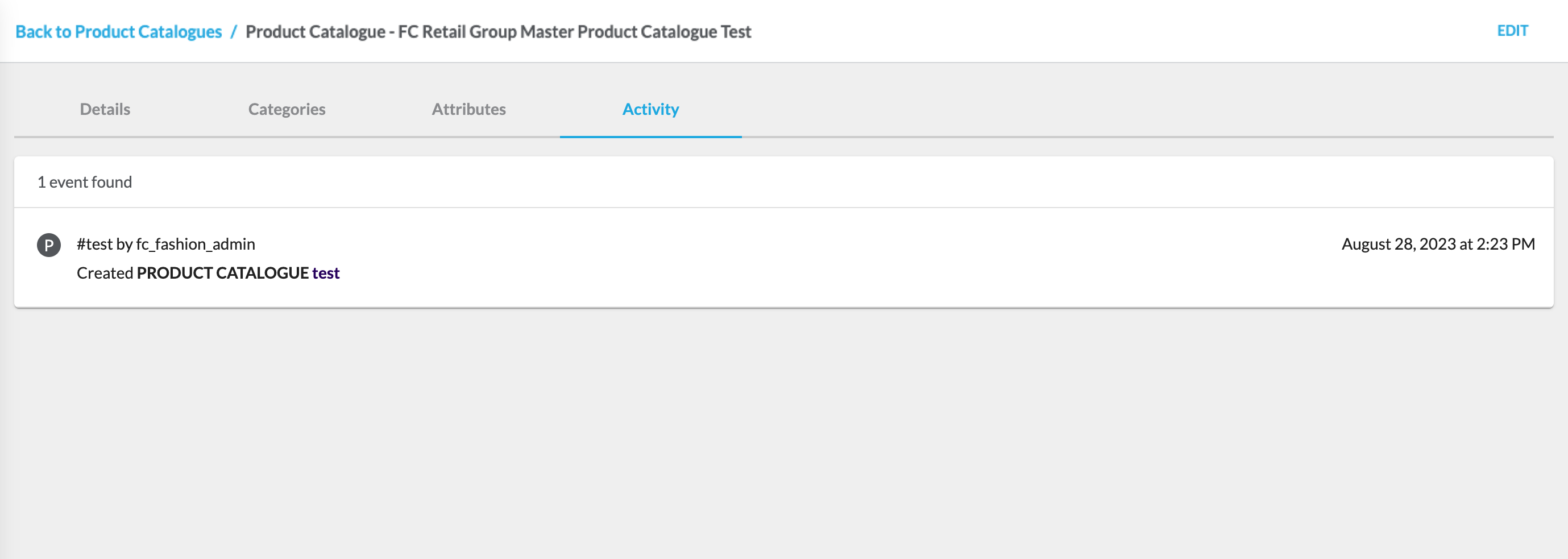
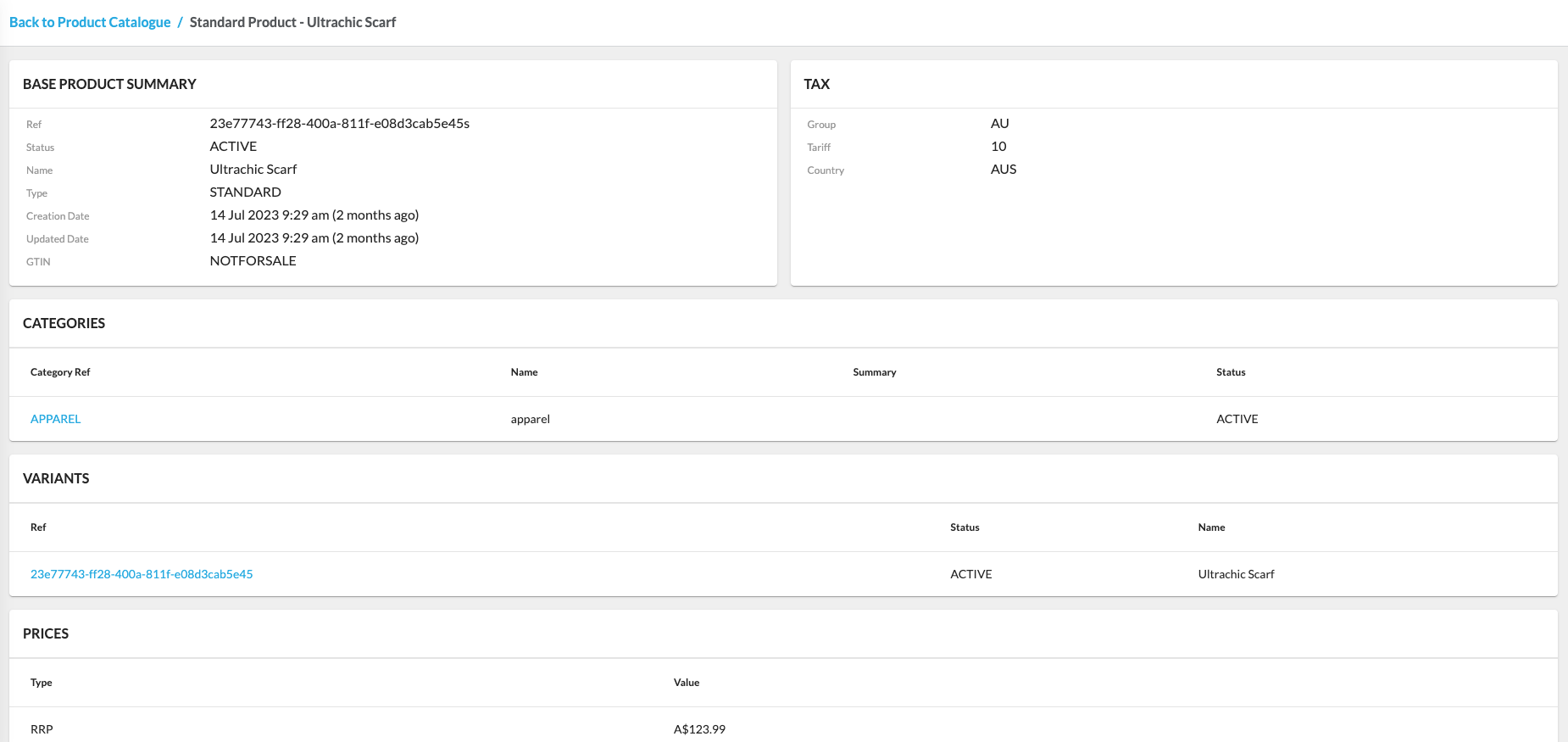

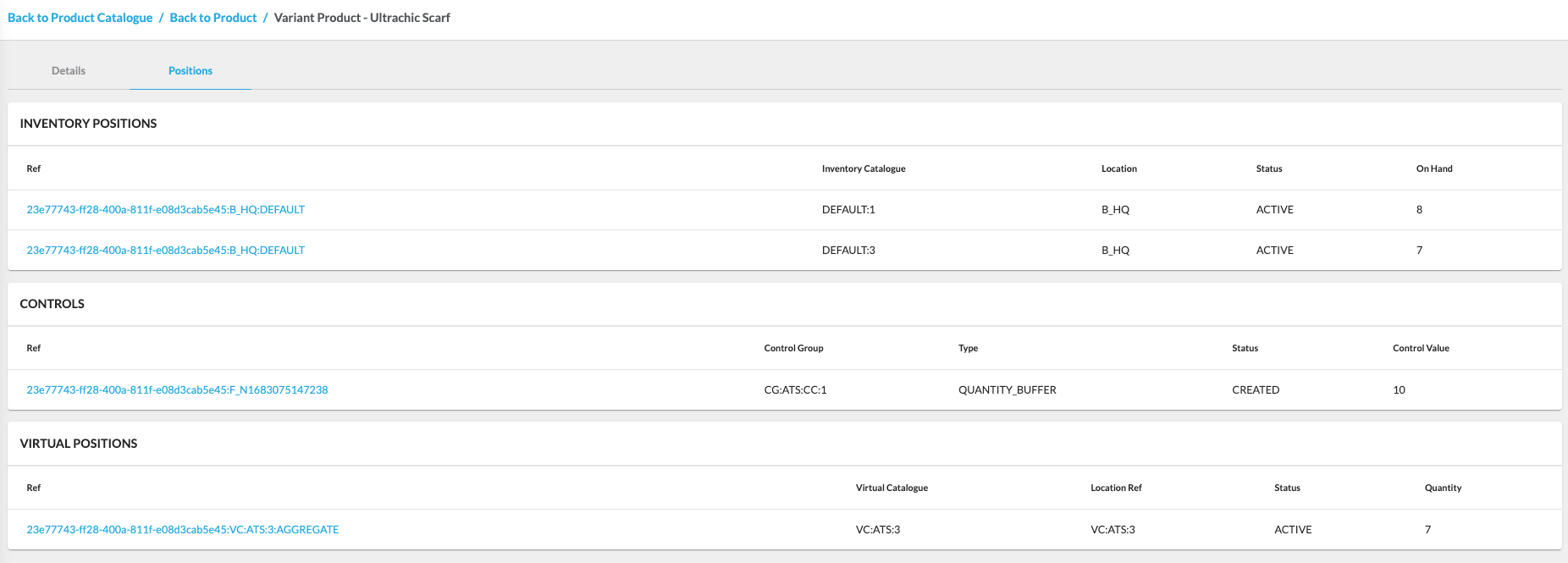
Unified View of Inventory
Author:
Yulia Andreyanova
Changed on:
7 Jan 2025
Overview
The Unified View of Inventory (UVOI) consolidates data from multiple locations and channels into a single, real-time interface. It provides centralized inventory search, advanced filtering, and customizable views. It enables you to monitor, analyze, and act on inventory data.
Key points
- Centralized Inventory Management: The Unified View of Inventory (UVOI) consolidates data from multiple locations and channels into a single, real-time interface, simplifying inventory management and improving decision-making.
- Advanced Filtering Capabilities: UVOI offers flexible filters for refining search results, including catalog, stock status, on-hand quantities, and product or location-specific criteria.
- Comprehensive and Customizable Views: The Inventory Search page provides a detailed overview of inventory, with drill-down capabilities for stock levels, available-to-sell quantities, and update histories. Users can navigate to location-specific or product-specific views and customize filters and criteria to tailor the experience to their operational needs.
The Unified View of Inventory (UVOI) offers an intuitive interface tailored to your needs. It empowers you to access, analyze, and act on real-time inventory information without complexity.
In this document, you will explore:
- Inventory Search Page: A centralized view with filter panels to refine inventory and virtual positions.
- Advanced Filtering Capabilities: Filters for catalog, stock status, on-hand quantities, and more.
- Inventory View by Location: Detailed insights into inventory at specific locations. Including stock levels and virtual positions.
- Inventory View by Product: A comprehensive look at product-specific inventory across locations, with key product details and statuses.
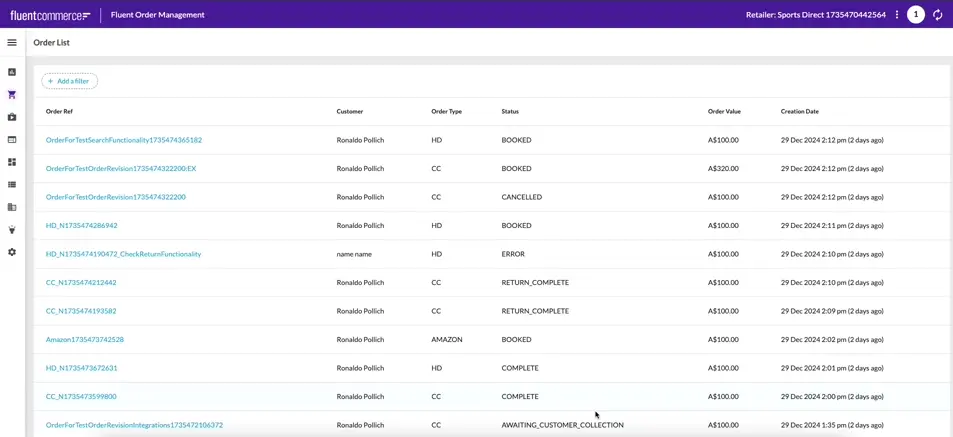
Inventory Search Page
The UVOI comes with a new menu section that is available out of the box in the Fluent OMS and Fluent Big Inventory Web Apps. The Inventory Search page displays a filter panel and a list of inventory positions as search results. Each inventory position expands into a detailed list of associated virtual positions, accessible via a dropdown.
The top filter panel refines inventory positions based on user-defined criteria, while the inner filter panel focuses on virtual positions. These two filter panels operate independently.
Advanced Filtering Capabilities
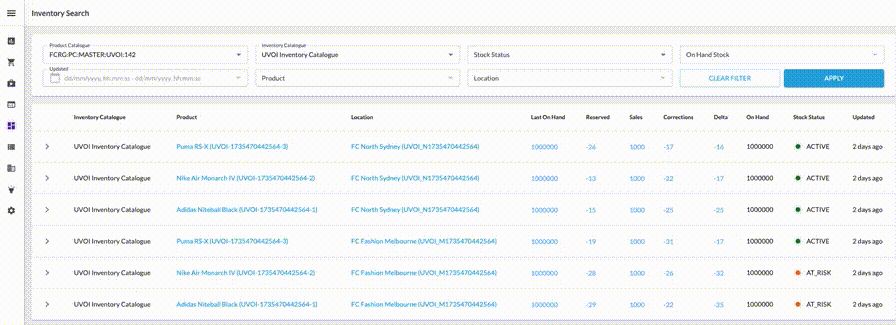
The Unified View of Inventory offers powerful and flexible filters to refine search results:
- Product Catalog Filter automatically applies the default product catalog upon visiting for the first time, as configured via the fc.oms.inventory.search.product.catalogue.default setting. The selected product catalog determines the product name displayed in the search results table. If the product associated with an inventory position belongs to a different product catalog, the product name will not appear. Instead, only the product reference will be shown.
- Inventory Catalog Filter controls the records displayed by linking to the inventory catalog defined via the fc.oms.inventory.search.inventory.catalogue.default setting. If no default inventory catalog is set, no records will appear.
- Stock Status Filter filters inventory positions by status as defined in the setting.
- OnHand Stock Filter allows filtering based on available on-hand stock. Users can set a range or filter inventory with values greater or smaller than a specific threshold.
- Updated Filter enables filtering by the last update timestamp of inventory positions.
- Product and Location Filters refine inventory positions by product or location. Clicking the filter opens an advanced form where users can search by name or reference. Matched records appear as selectable chips.
Once filters are applied, the panel updates the results to display only the inventory positions matching the selected criteria.
Inventory Position Details
The Inventory Search page presents a detailed overview of inventory positions, offering important information at a glance. Users can view the inventory catalog name, associated product, and location, along with calculated on-hand quantities and aggregations of inventory quantities. Additionally, it displays the stock status and timestamps for the most recent updates, ensuring complete visibility into inventory changes.

Clicking any quantity cell opens a Type History Drawer, displaying the history of changes for that inventory quantity type.
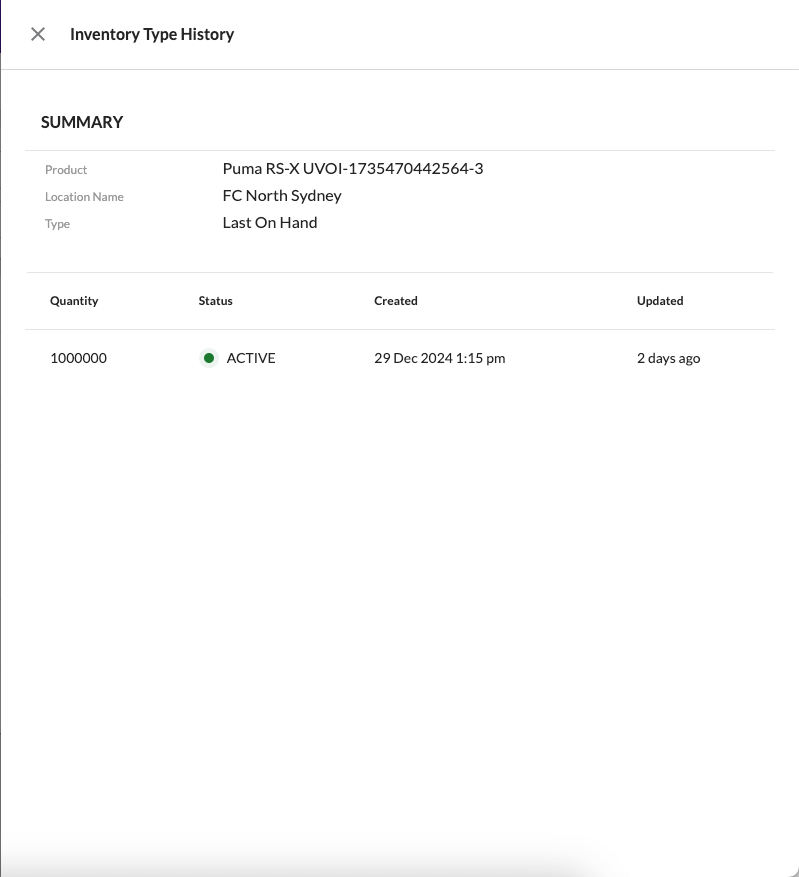
Each inventory position contains an inner list of associated virtual positions, enabling a more granular view of inventory filtering by virtual catalog, available stock, and virtual stock statuses.

From an inventory position, users can navigate to detailed inventory views:
- By Location: Focuses on inventory specific to a chosen location.
- By Product: Displays inventory details for a specific product, including stock levels across locations and virtual positions.
Both pages carry over filters from the main search but exclude inner filter settings for virtual positions.
Inventory View by Location
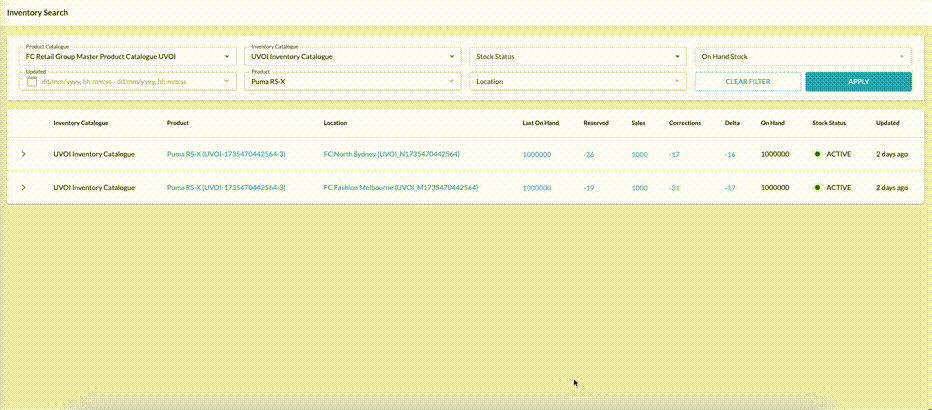
The Inventory View by Location page gives a clear and detailed look at a specific location’s inventory. Users can click on a location name from the Inventory Search page to access this view. The location reference will still show if someone doesn’t have the required permissions, but it won’t be clickable, keeping restricted information protected.
This page provides the location’s address, working hours, and a full list of inventory positions. It also includes a filter panel—without the location filter—and a detailed inner list of virtual positions linked to each inventory entry. This ensures that all the key inventory details for that location are easy to find.
Filters from the Inventory Search page carry over to this detailed view, making it easier to continue working with the same data. However, filters from the inner list do not apply. A breadcrumb link at the top allows users to return to the Inventory Search page, keeping any previously applied filters in place, even when switching between different details pages.
Inventory View by Product
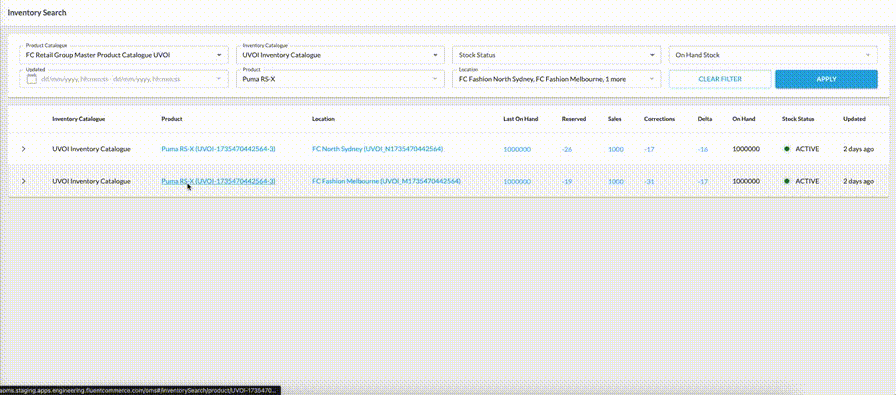
The Inventory by Product page provides a detailed view of inventory information for a specific product. Users can click on the product name from the Inventory Search page to access this page. If the selected product catalog is incorrect or doesn’t include the product, navigation to the product’s details will be restricted, and only the product reference will be displayed without a clickable link.
On the UVOI by Product page, users can see key product details, such as its name, status, category, and description, along with an image of the product. The page also features a filter panel—excluding the product filter—and an updated list of inventory positions, complete with their associated virtual positions.
Filters applied on the Inventory Search page remain active on this page, helping users maintain their focus on relevant data. Inner list filters, however, do not carry over. A breadcrumb navigation link allows users to return to the Inventory Search page with their original filters preserved, even when moving between multiple details pages.
Optimizing Stock, Enhancing Experiences
By combining advanced filtering capabilities, real-time updates, and intuitive navigation, UVOI ensures that users—from retail managers to eCommerce teams—can easily make data-driven decisions.
Whether you're monitoring stock by location or tracking inventory across sales channels, UVOI empowers businesses to maintain optimal stock levels, reduce inefficiencies, and enhance the customer experience.
Inventory Module Overview
Author:
Fluent Commerce
Changed on:
22 Aug 2024
Overview
The Inventory module of the Fluent Web app provides comprehensive inventory management capabilities:
- Inventory visibility
- Inventory allocation
- The total quantity of stock for a specific item (stock on hand(SOH)) and the status of that inventory
- Available to promise inventory levels
- Inventory buffers to reduce overselling of products
Key points
- The Fluent Web app's Inventory module offers a comprehensive suite of capabilities, including inventory visibility, allocation, total stock quantity (stock on hand), inventory status, available-to-promise levels, and strategically implemented buffers to prevent product overselling.
- The module is equipped with various configurations, such as Inventory Catalogues, Control Groups, Virtual Catalogues, Cross-Catalogue Views, and Location Inventory Views, providing users with versatile tools to tailor their inventory management approach according to specific business needs and scenarios.
The module contains the following configurations:
- Inventory Catalogues
- Control Groups
- Virtual Catalogues
- Cross-Catalogue Views
- Location Inventory Views
Inventory Catalogues
An Inventory Catalogue consists of inventory positions that can be aggregated from multiple sources. Inventory catalogues hold stock on hand (SOH) of products, variants, and groups. The Inventory Catalogues configuration allows users to create and manage inventory catalogues.
Inventory Catalogue configuration contains the list of inventory catalogues for a particular retailer. Clicking
`Catalogue Ref`
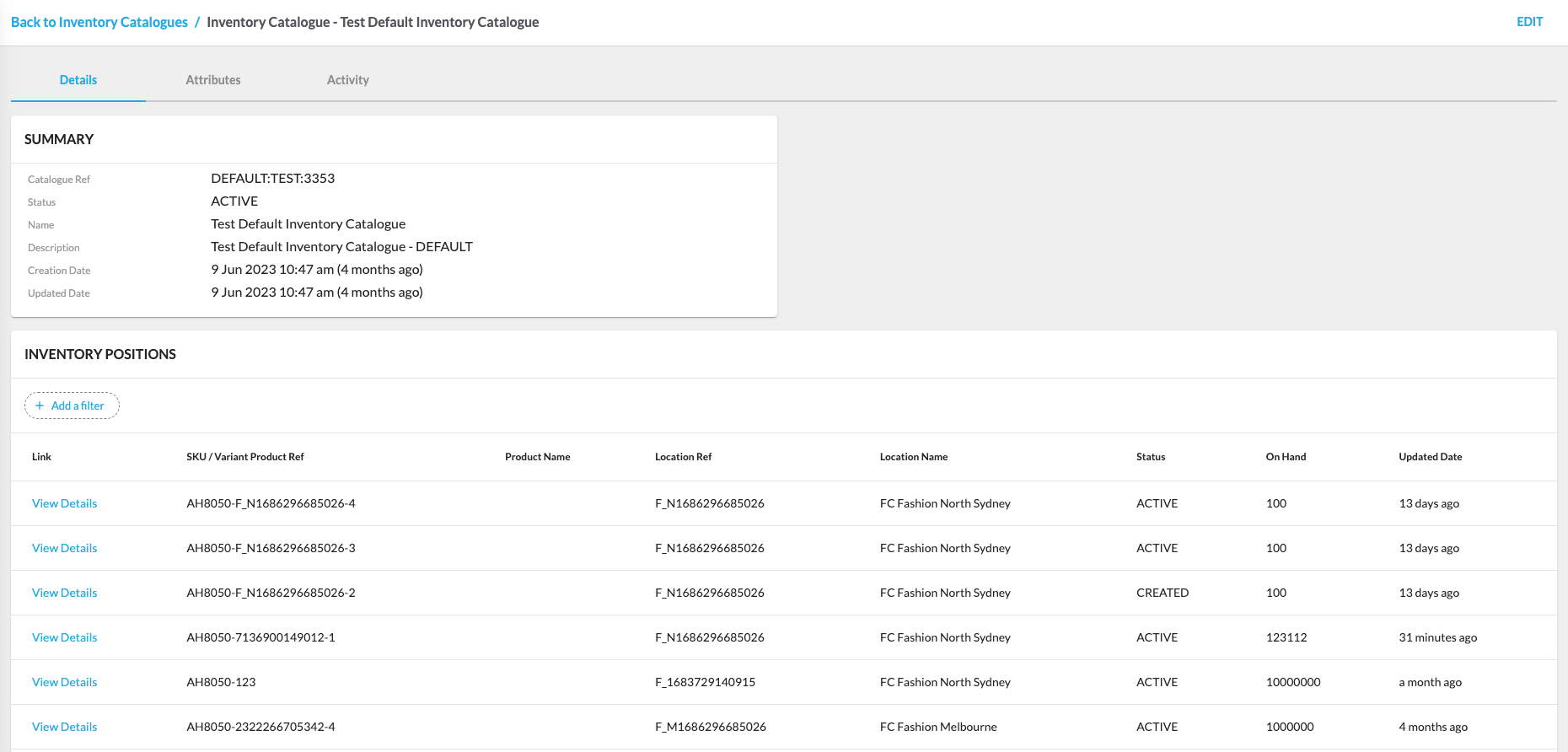


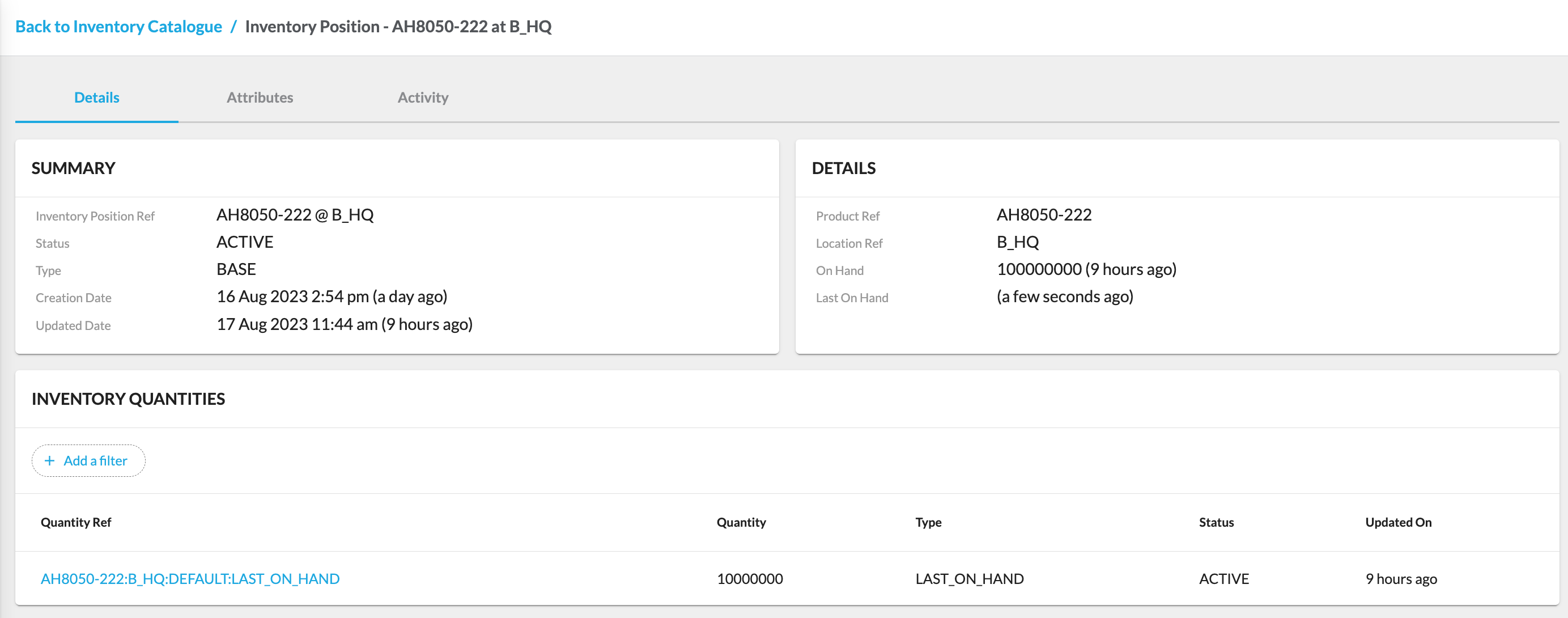
Control Groups
Control Groups manage buffers and safety stock when providing virtual inventory to sales channels.
Control Groups configuration contains the list of control groups for a particular retailer. Clicking
`Ref`


Virtual Catalogues
Virtual Catalogues represent fast-moving dynamic data such as buffered inventory and multiple dynamic inventory counters. A Virtual Catalogue commonly consists of virtual positions based on products in a location, products in a network, and products in a category based on the requirements of retailers.
Virtual catalogue configuration contains the list of virtual catalogues for a particular retailer. Clicking
`Ref`
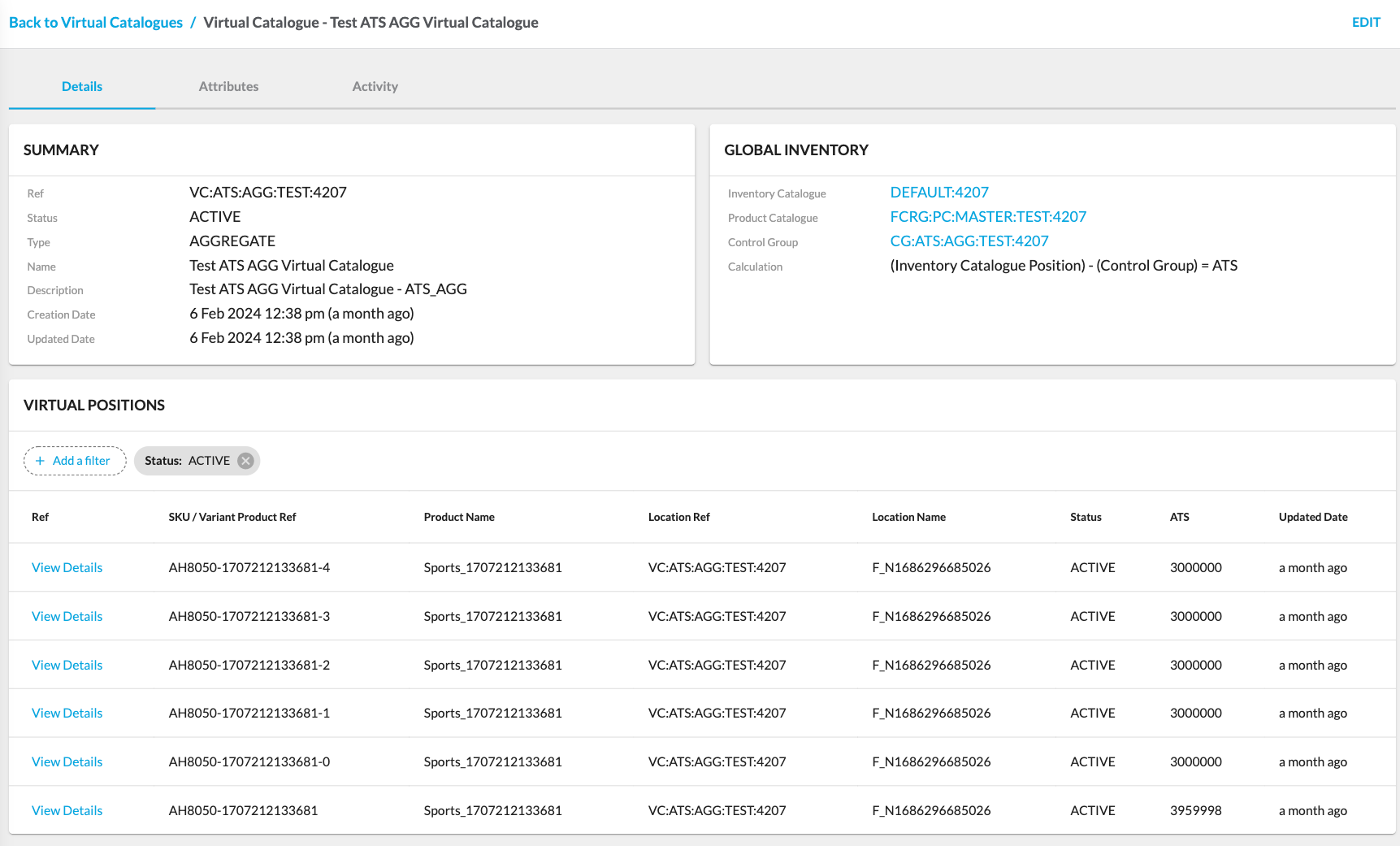


Cross-Catalogue Views
Cross-Catalogue Views represent displaying information from the cross-catalogue perspective (Virtual Catalogue, Inventory Catalogue, and Control Group) for a particular retailer.
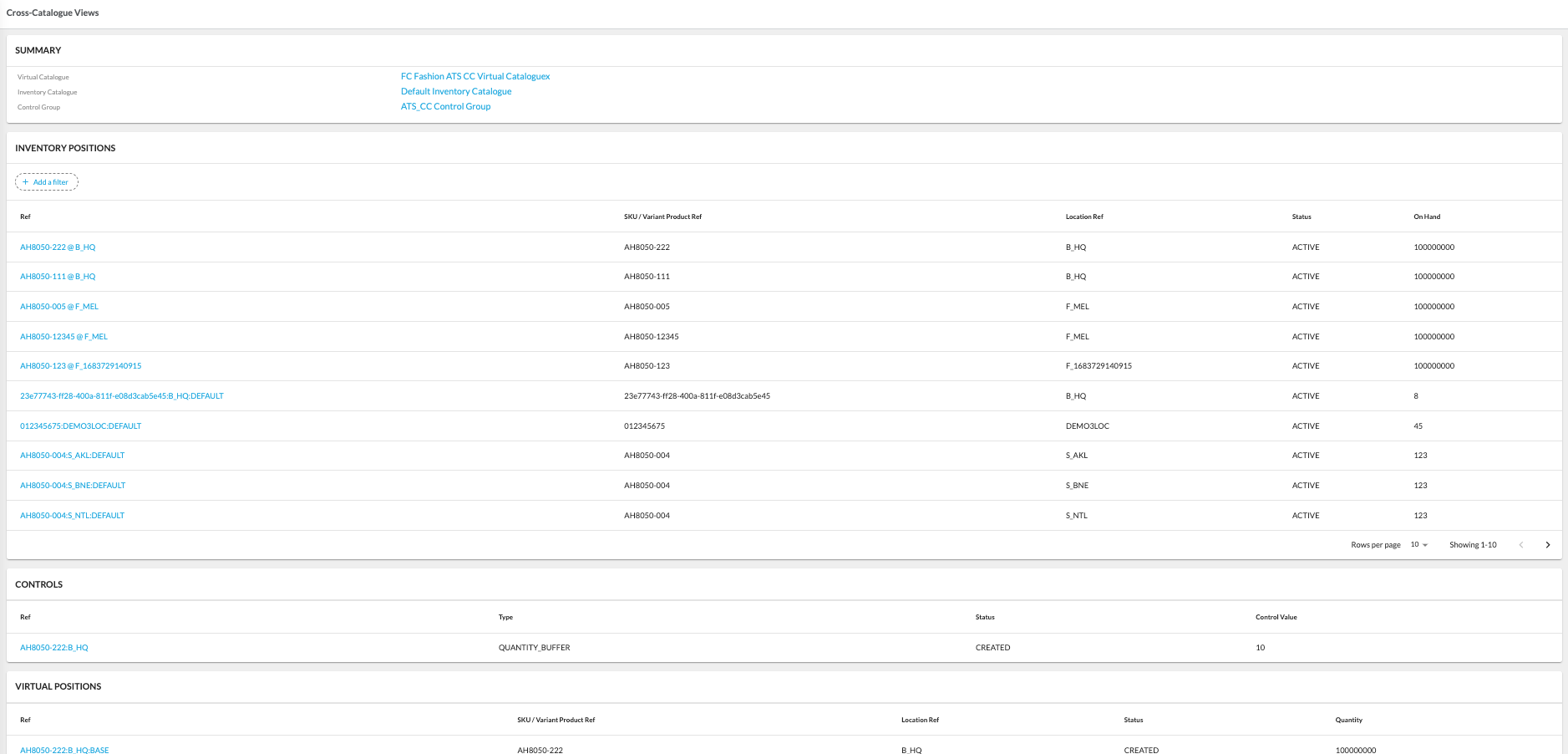
Location Inventory Views
Location Inventory Views represent inventory from a location perspective. The Location Inventory Views page displays the list of locations.

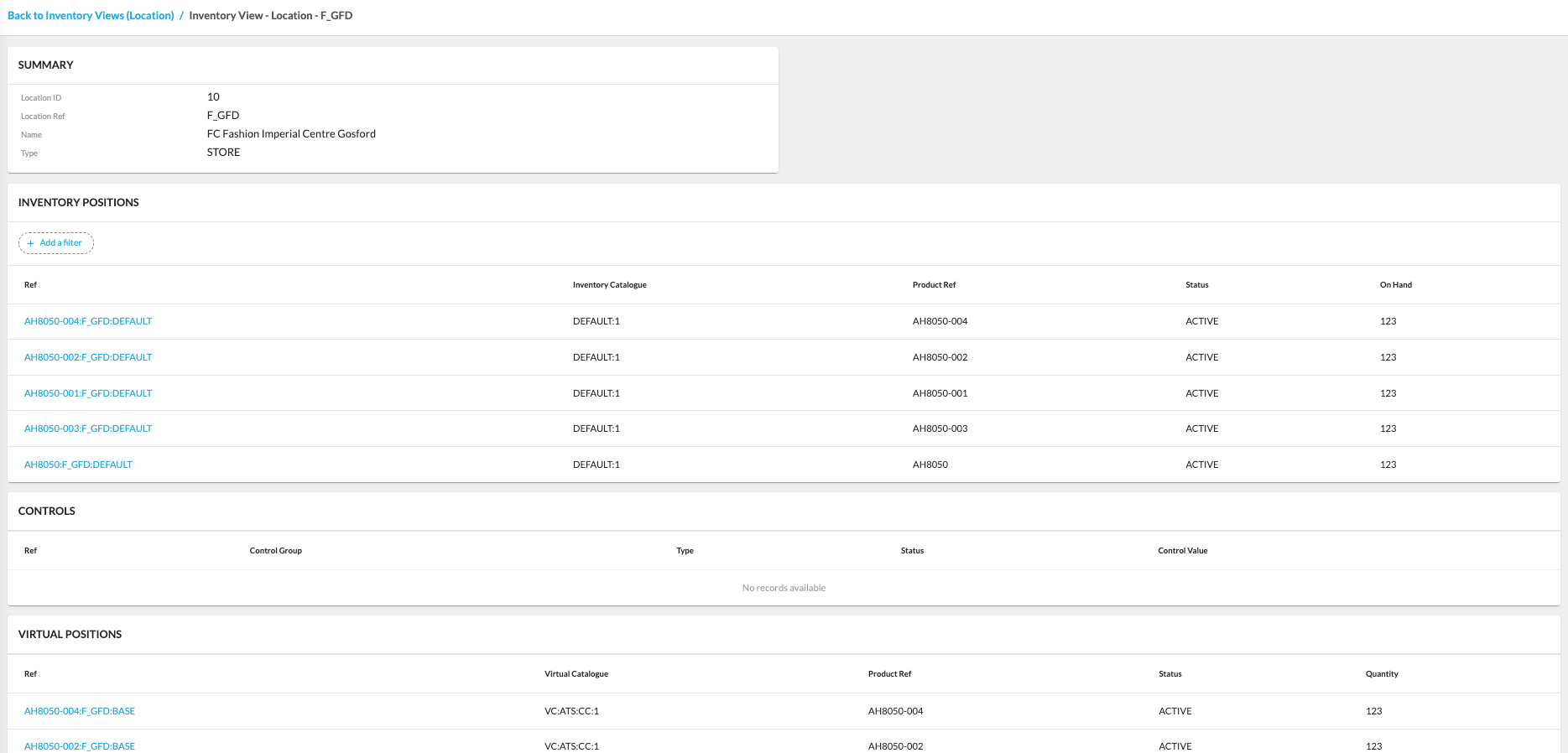
Features
The Inventory module provides several features that allow to manage inventory efficiently.
Manage Control Groups
Control Groups represent the collection of controls for a particular Virtual Catalogue. As standard, a Control Group is created for each Virtual Catalogue with the Control Group reference added to the
`controlGroupRef`A Control represents a specific value to be applied as part of a Virtual Position's AVAILABLE TO SELL calculation. Controls can be of multiple types, each determining how the control is applied and to what Virtual Positions. These can be prioritized to be calculated in specific orders or instead of other Controls.
For more details about the specifics of creating and editing Control Groups, check out the following guide.
Manage Virtual Catalogues
The Virtual Catalogue module allows users to create and manage virtual catalogs.
For more details about the specifics of creating and editing virtual catalogs, check out the following guide.
Manage Inventory Catalogues
The InventoryCatalogue module allows users to create and manage inventory catalogs.
For more details about the specifics of creating and editing inventory catalogs, check out the following guide.
Related content
Fluent Store Configuration in OMS Web App
Author:
Fluent Commerce
Changed on:
19 Sept 2024
Overview
The Fluent Store Web App empowers retailers to enhance their operational efficiency by transforming stores into fulfillment centers and optimizing inventory management, ultimately delivering a superior customer experience through streamlined order fulfillment and improved inventory control.
The app contains the following configurations:
- All Locations
- Stores
- Warehouses
- Networks
Key points
- Stores are transformed into efficient fulfillment centers, ensuring a seamless customer experience through optimized order fulfillment and superior inventory control.
- With configurations for all Locations, Stores, Warehouses, and Networks, the app provides a comprehensive toolkit, enabling retailers to manage their entire ecosystem.
Features
Location Overview and Detailed Information
- Get a comprehensive view of all physical locations within your retail ecosystem.
- Access in-depth details about each location, such as location-specific information, opening hours, and a convenient "Location Finder" tool for easy navigation.
- Understand the operational status of each location while efficiently organizing them into logical networks, allowing for informed decision-making regarding order fulfillment and customer collection.
- Efficiently manage storage areas within your locations to optimize inventory control, enabling precise allocation and tracking of items for enhanced order fulfillment and storage efficiency.
Store and Warehouse Details
- Access specifics about your stores and warehouses, including information on the networks they belong to, storage areas, schedules, and order processing waves.
- Utilize stores as inventory sources for fulfilling customer orders while ensuring that these locations are not only for collections but also as integral parts of your supply chain.
Networks
- Organize your locations into logical or geographic categories known as networks, simplifying management and optimization efforts.
- Access comprehensive data about your networks, including network attributes, locations, and affiliated retailers.
A location is a physical place that serves as a hub for shipping and receiving items you're selling. These can include warehouses, retail stores, and third-party vendor facilities, which play a crucial role in your supply chain. In the Locations configuration, you can access the Locations List page, which presents the catalogue of existing locations. If you want to delve deeper into a particular location's specifics, click on
`Location Ref`
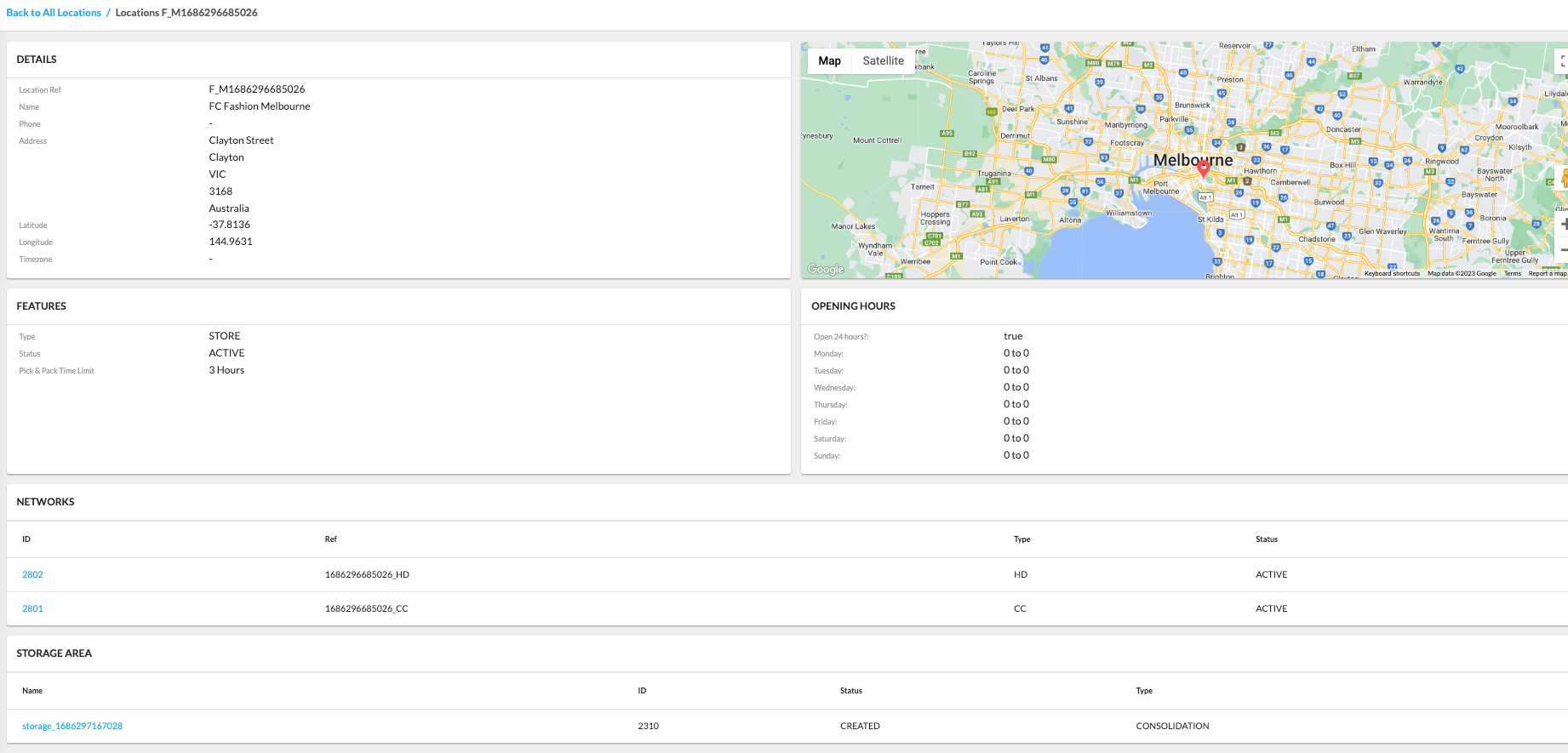
Stores are specific locations primarily utilized as sources of inventory for fulfilling customer orders. They also serve as collection points for customers to pick up their purchases, providing a seamless shopping experience. The Stores configuration includes the Stores List page, where you can view the existing stores. If you click on
`Ref`
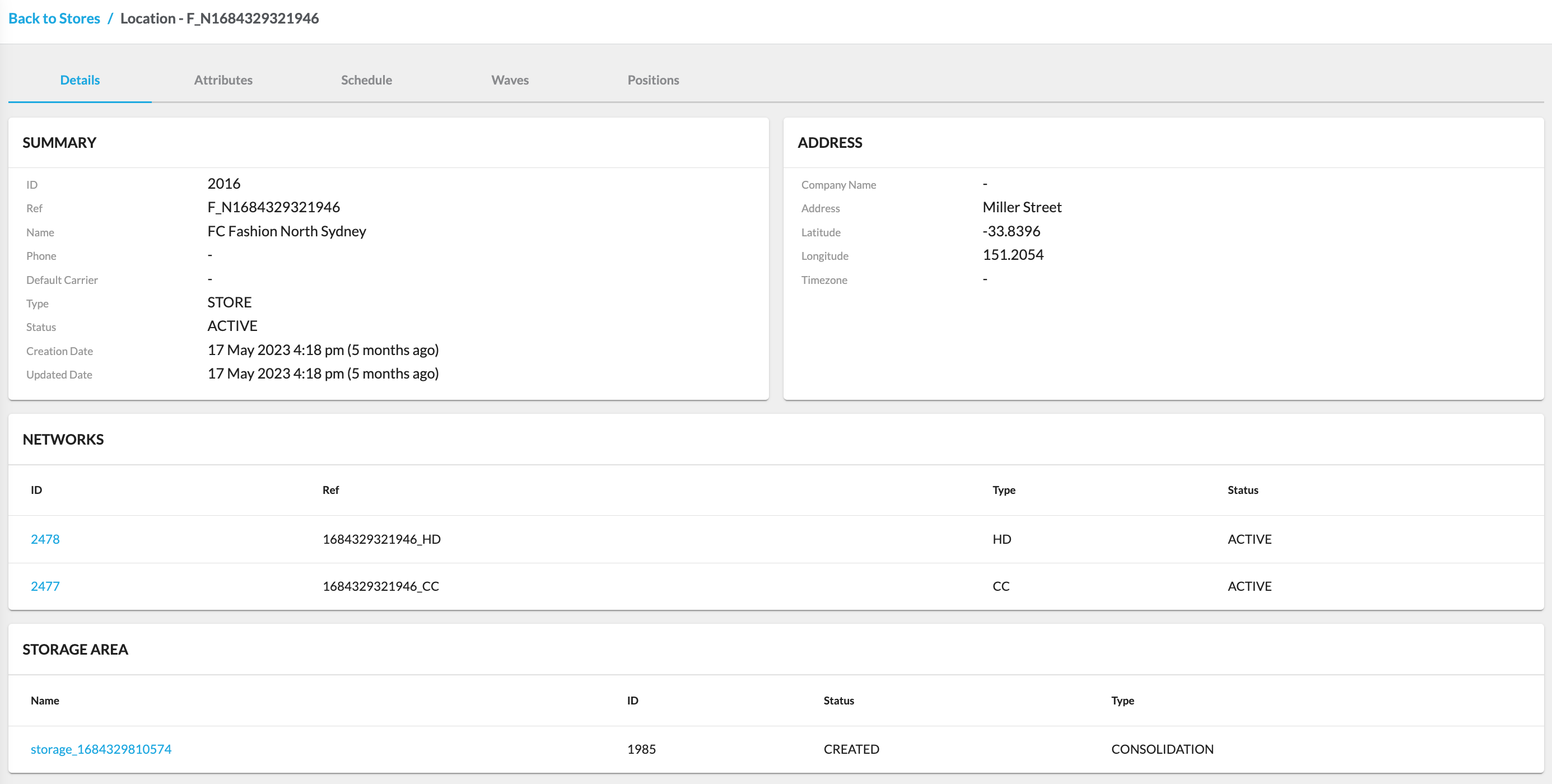


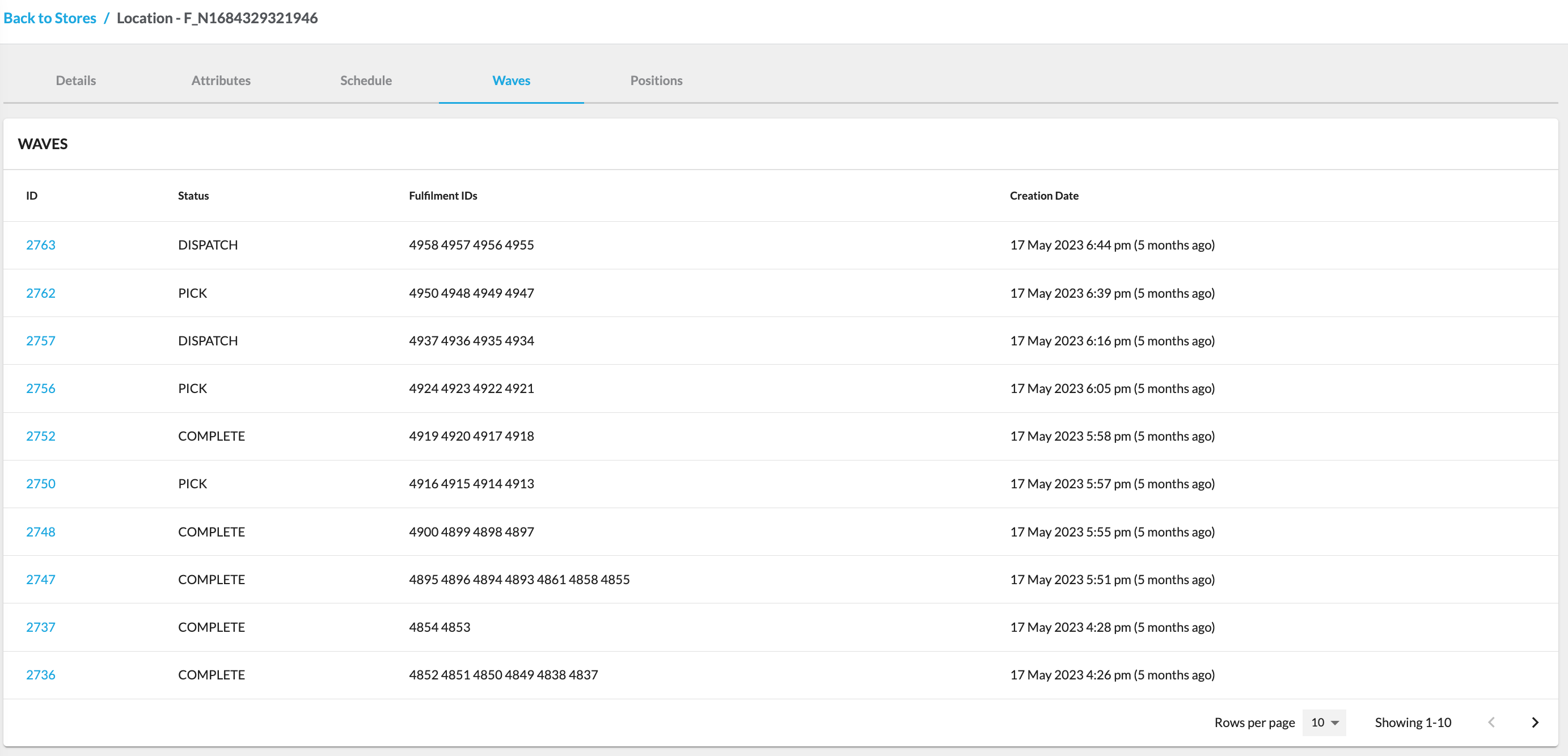
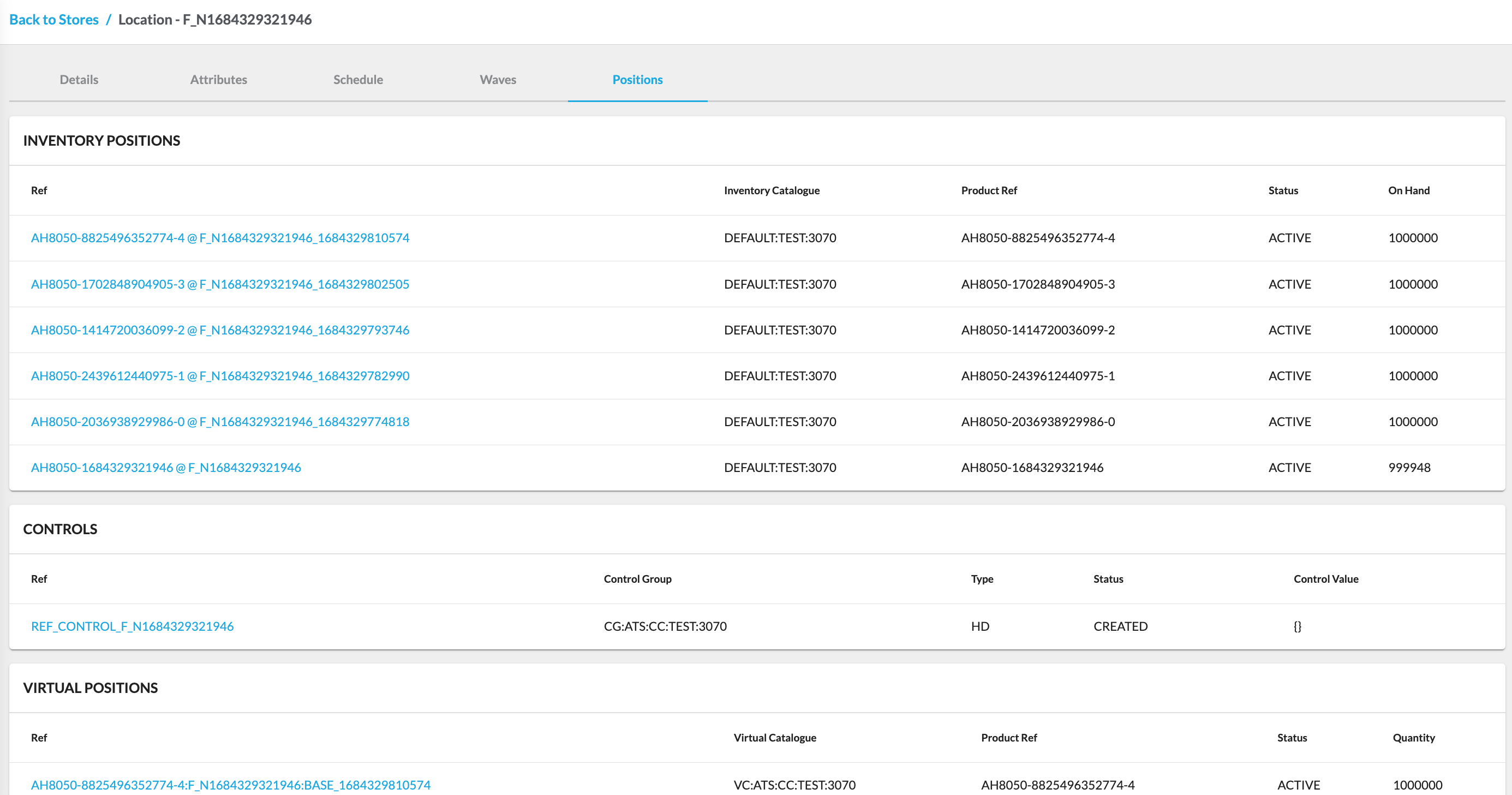
Warehouses are centralized locations dedicated to stocking inventory for order fulfillment. While they are essential for efficient supply chain operations, they are typically not designed for customer collection and are more focused on inventory management and distribution. In the Warehouses configuration, you'll find the Warehouses List page, offering a glimpse of the available warehouses. Clicking on
`Ref`
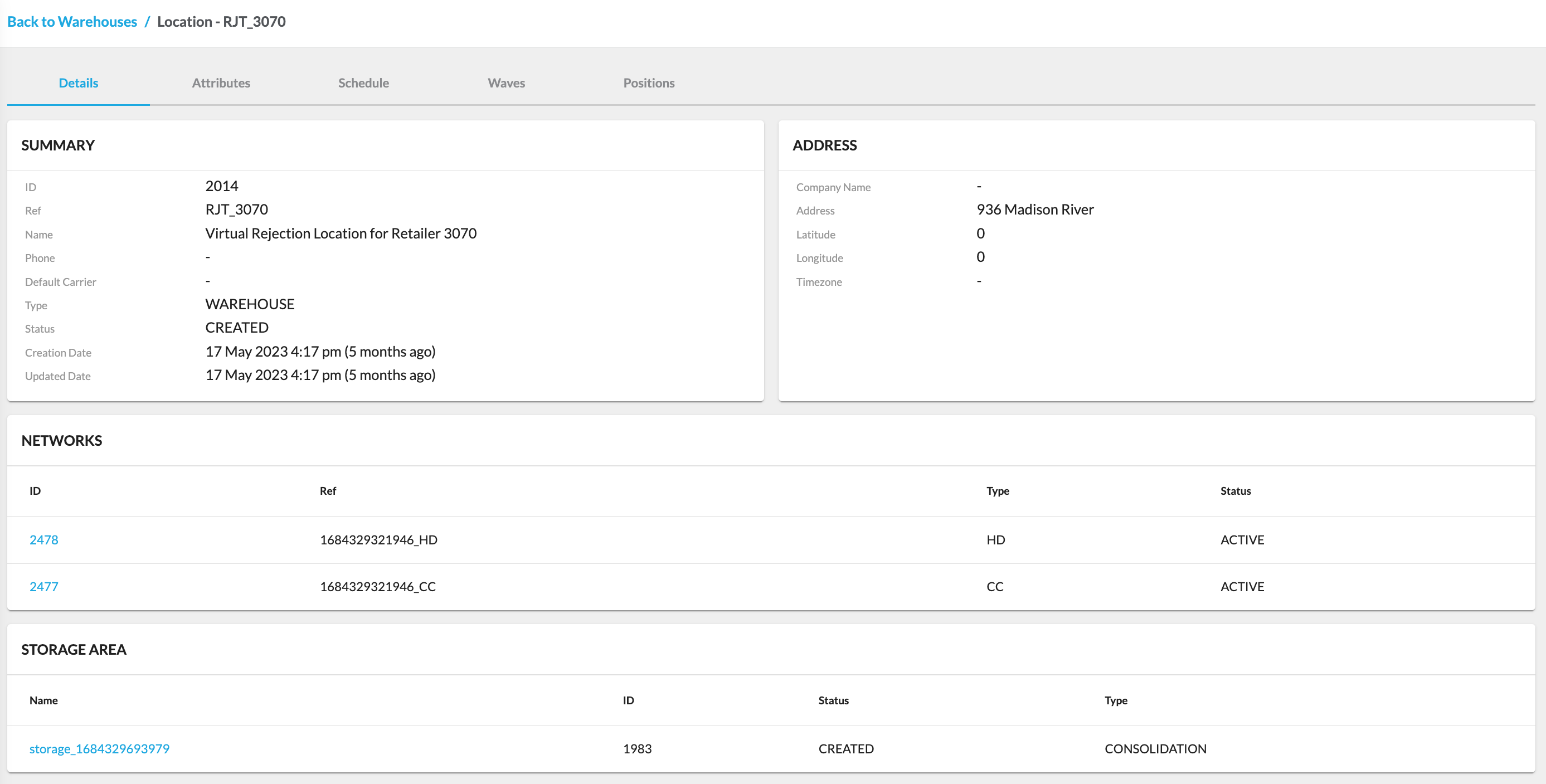



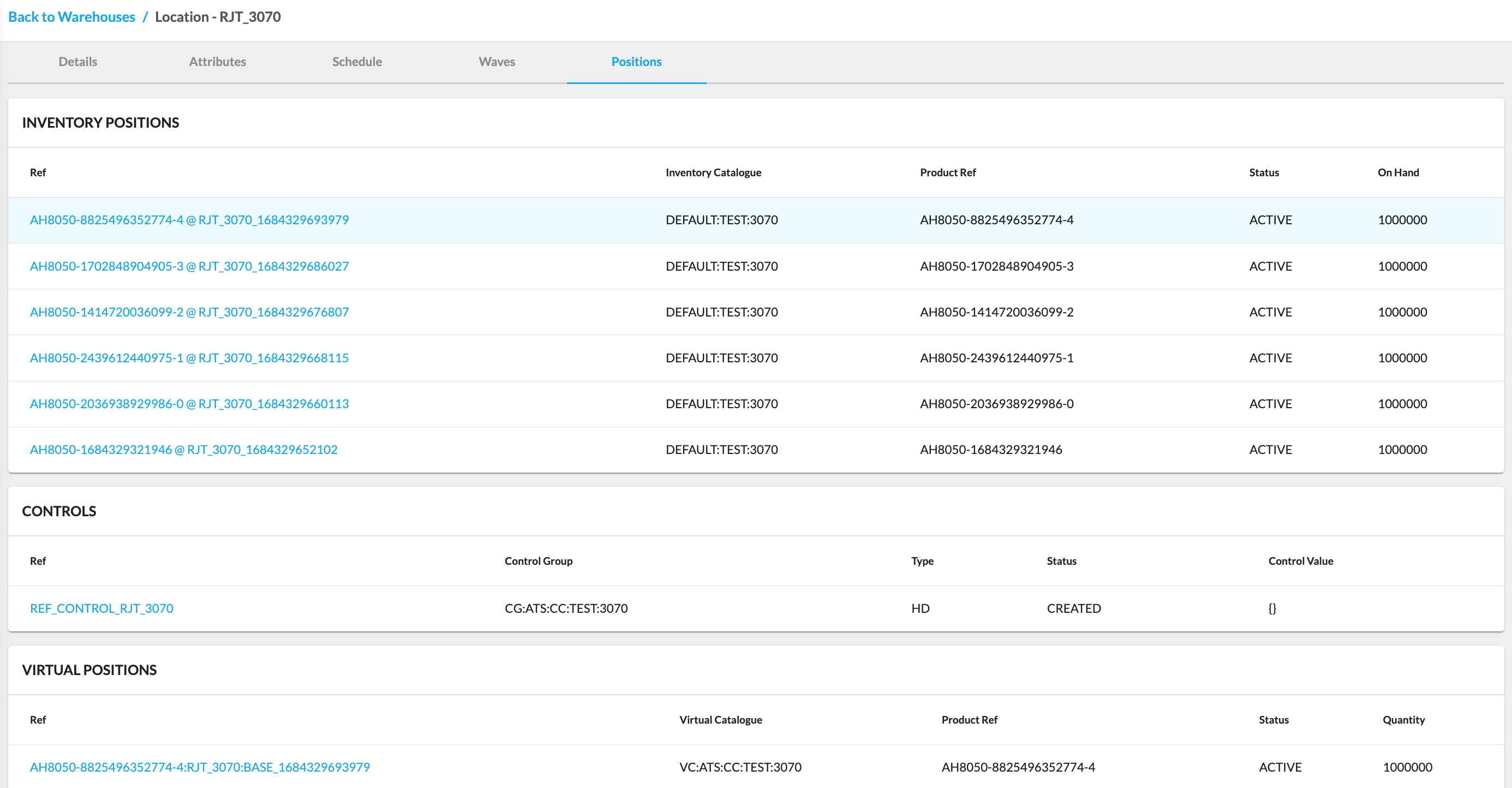
Networks are groups of locations organized into logical or geographic categories. They help you manage and optimize the operations of multiple locations, making it easier to coordinate order routing, inventory allocation, and other logistical aspects of your business. Clicking on (Network)
`Ref`
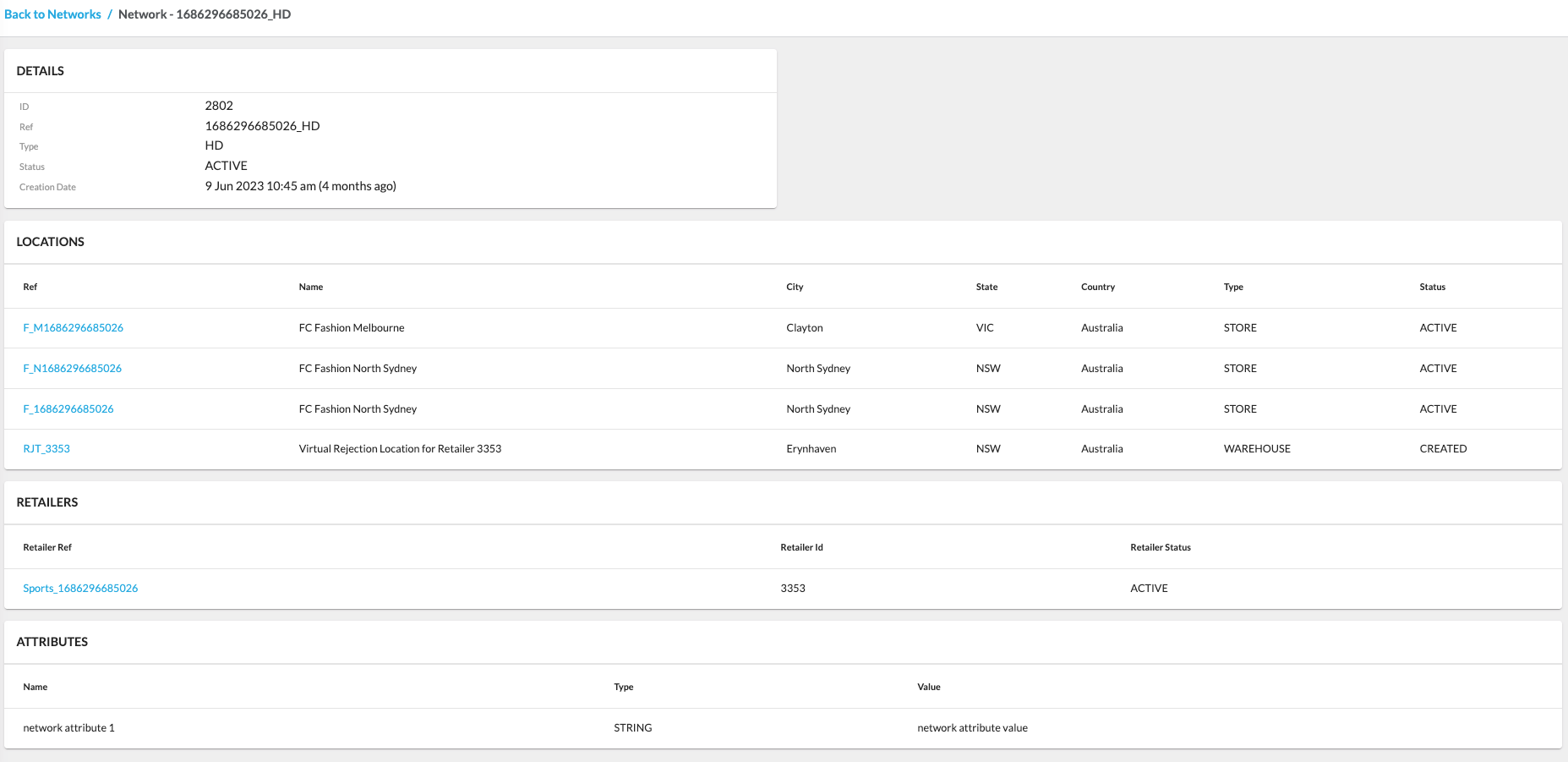
Related content
Insights
Authors:
Fluent Commerce, Kirill Gaiduk
Changed on:
15 Mar 2024
Overview
The Insights module is a comprehensive repository of system Events, representing occurrences or triggers within the Fluent Platform. These Events, like changes in inventory position or entity states, act as notifications, prompting specific workflows and providing a dynamic overview accessible through a user-friendly configuration featuring the Events Search Form, the Events Search Results, and the Event Details Drawer for efficient information retrieval.
Key points
- The Insights module is a comprehensive repository providing full information about system Events, representing occurrences and triggers that prompt actions or log activities within the Fluent Platform.
- With a user-friendly configuration, the module enables efficient interaction through the Events Search Form, providing filtered event searches and responsive Events Search Results. The Event Details Drawer ensures users can seamlessly access detailed event information without losing search results or experiencing delays in page navigation.
Insights Module
The Insights module contains the full information about Events.
An Event represents something that has, will, or is happening within the system. An Event is typically used to ask or trigger the system to do something or log activity of what has occurred within the system.
Essentially, events are notifications within the system that various internal or external systems can consume to take further action.
Events Page
The Events page is powered with the Events Search Component.
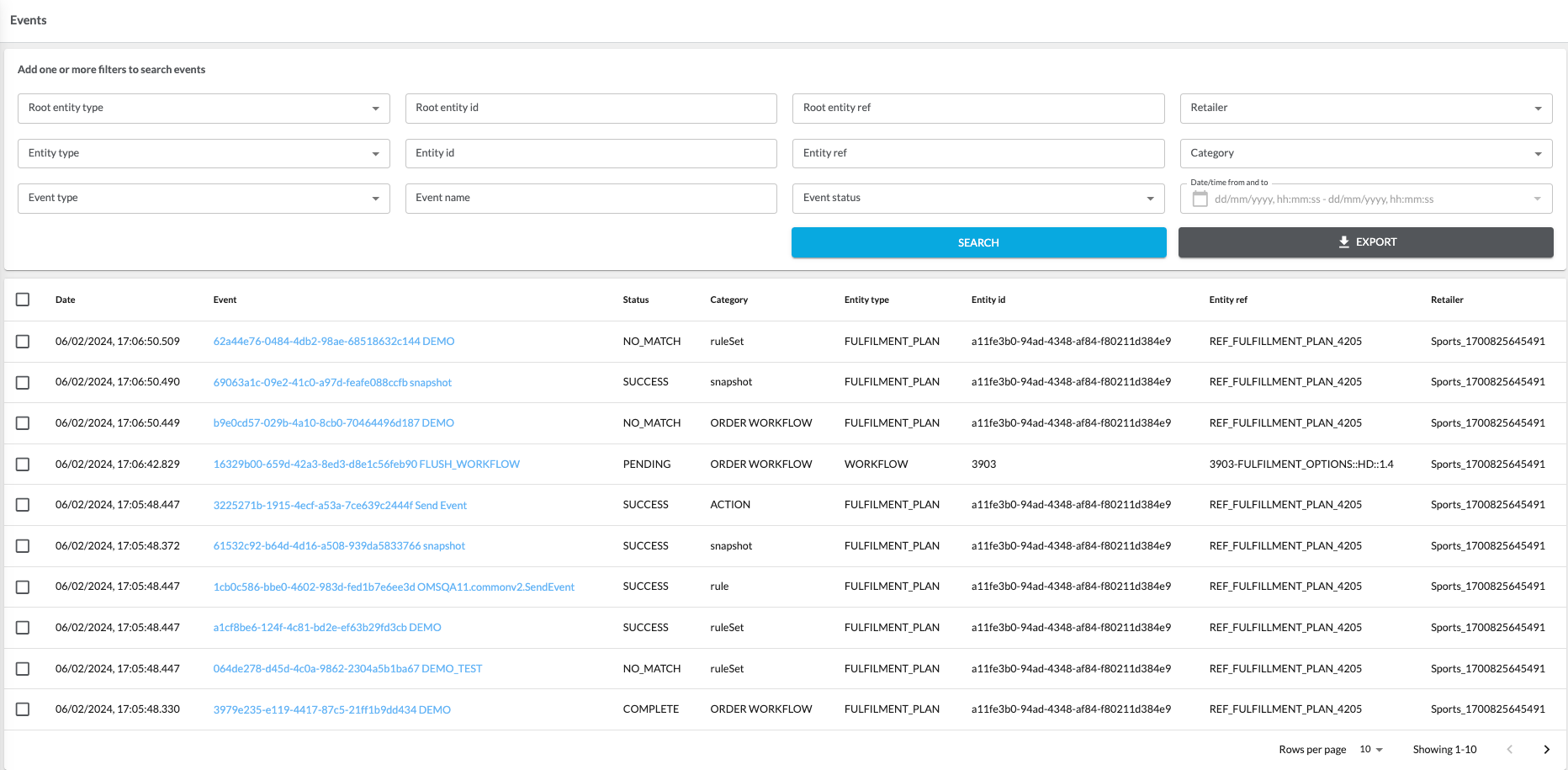
The Events Search consists of the following sections:
Events Search Form

The Search Form contains:
- Filter input fields;
- SEARCH button;
- EXPORT button;
- CLEAR FILTERS button (hidden when no filters are applied).
Events Search Results

The list of events matching the filters criteria selected is presented in a table view.
Event Details Drawer
The drawer displays a detailed information about a specific event selected from the list of Events Search Results.
Events Export
Events export capability allows customers and partners to share event logs with support:
- A JSON file containing an array of the events' bodies is generated on EXPORT button click.
- The EXPORT button is disabled when the Events Search Results are empty.
Related content
Admin UI in Fluent OMS Web App
Author:
Fluent Commerce
Changed on:
3 Oct 2024
Overview
The Admin user interface in the Fluent OMS Web App provides comprehensive administrative capabilities to manage the entire system efficiently.
Key points
- The Admin section helps in managing users, retailers, settings, etc.
- It contains some or all of the following: Retailers, Carriers, Users, Roles and Permissions, and Settings.
Admin Management in Fluent OMS Web App
Manage Users
User management is critical to any application seeking a personalized and secure user experience.
For more details about the specifics of the create and edit users features, check out the following guide.
Manage Roles and Permissions
With roles and permission management, administrators can easily grant or restrict access to the application based on the user’s role or job function. By defining different roles and permissions, administrators can ensure that users only have access to the functionalities and data they need to perform their job function.
For more details about the specifics of creating and editing roles and permissions, check out the following guide.
Manage Settings
Setting management allows you to adjust the application to your business needs.
For more details about the specifics of the create and edit settings features, check out the following guide.
Retailers
See also the Retailer page component.
Retailers configuration contains the list of existing retailers. Clicking (Retailer)
`ID`

Carriers
See the Carriers page for more details.
Users
Users configuration contains the Users List page, which displays the list of existing users. This feature provides a view of all users within the Retailer, including their username, first and last name, type, roles, and status. This list is crucial for administrators to manage user access and ensure that users have the appropriate permissions to perform their tasks within the app.
Clicking the
`Username`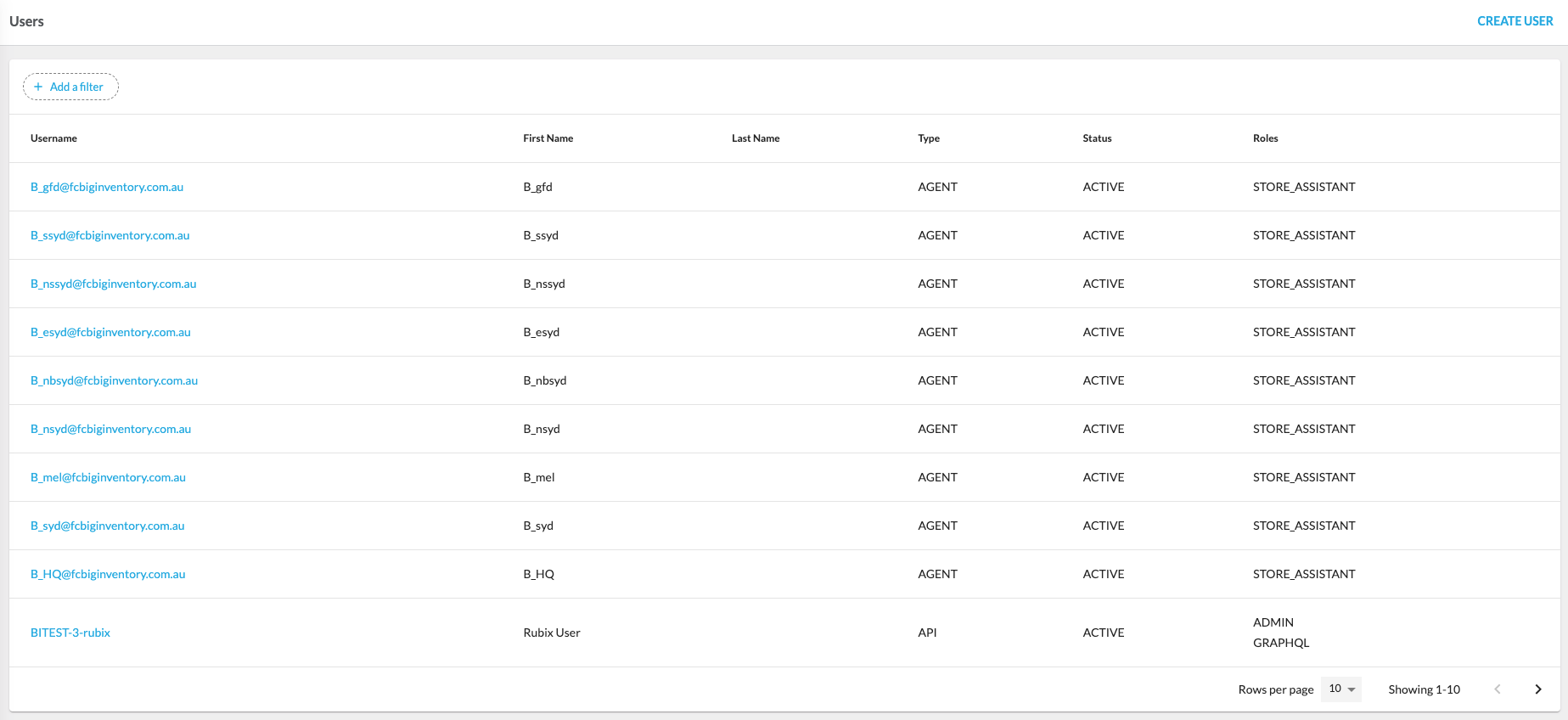
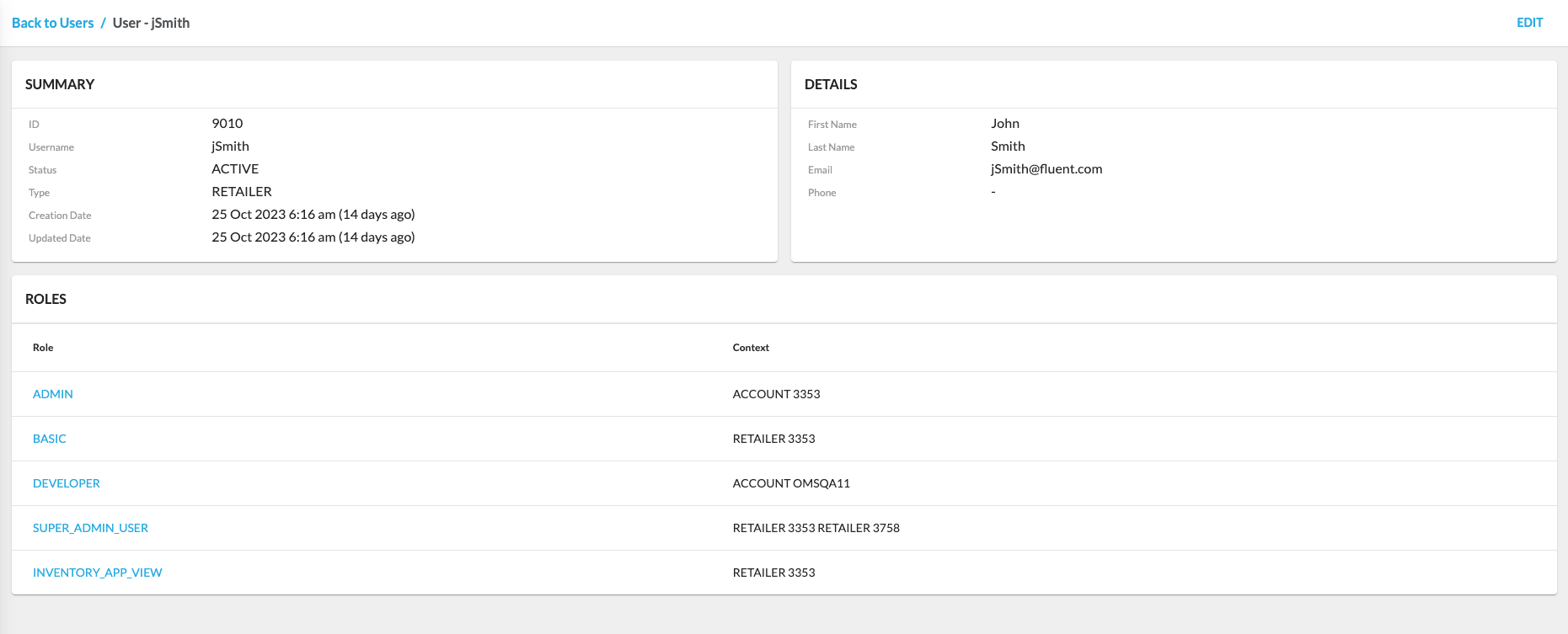
Roles & Permissions
Roles and permission management allow control of user access to different functionalities and data.
Multiple roles allow users to perform any actions within any or all of the roles assigned to them. Roles and permission management enhances security and helps a Retailer manage a user base efficiently.
Roles & Permissions configuration contains the Roles & Permissions page, which displays each role’s list of permissions. Clicking
`Role Name`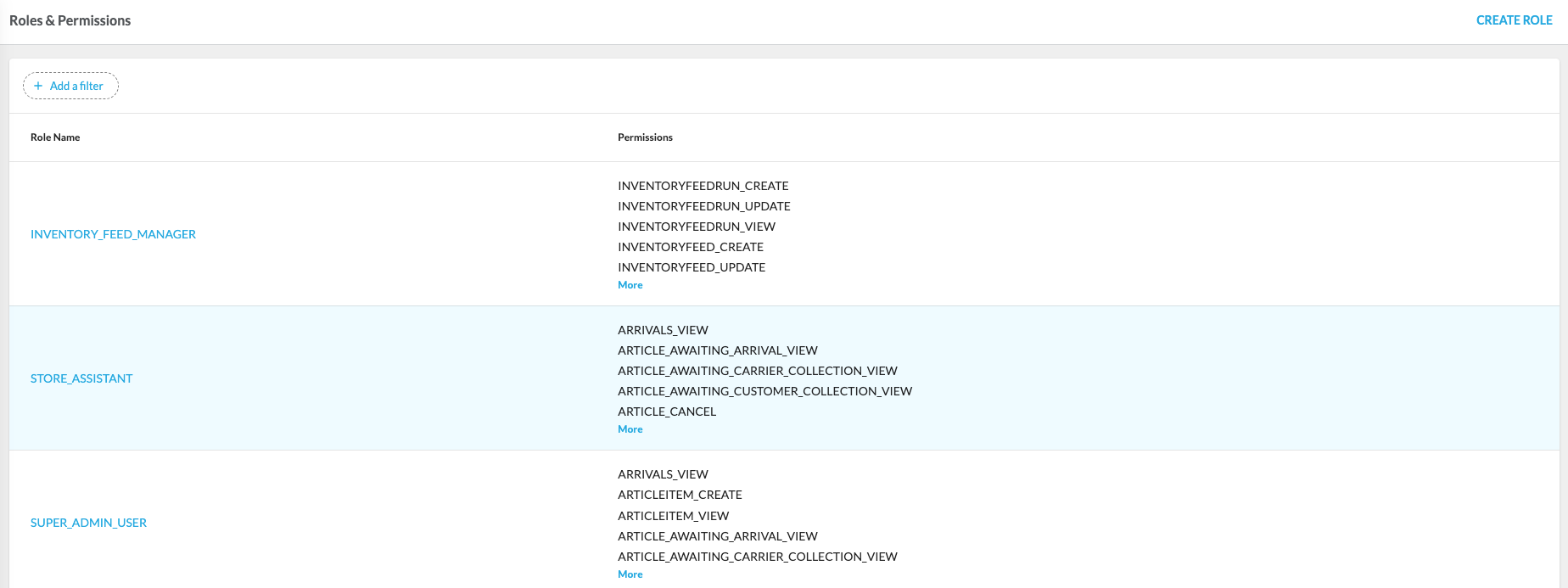

Settings
Settings configuration allows the management of business rules by configuring settings on different levels, e.g., ACCOUNT or RETAILER. Settings configuration contains the Settings List page, which displays the list of settings. Clicking
`Setting Name`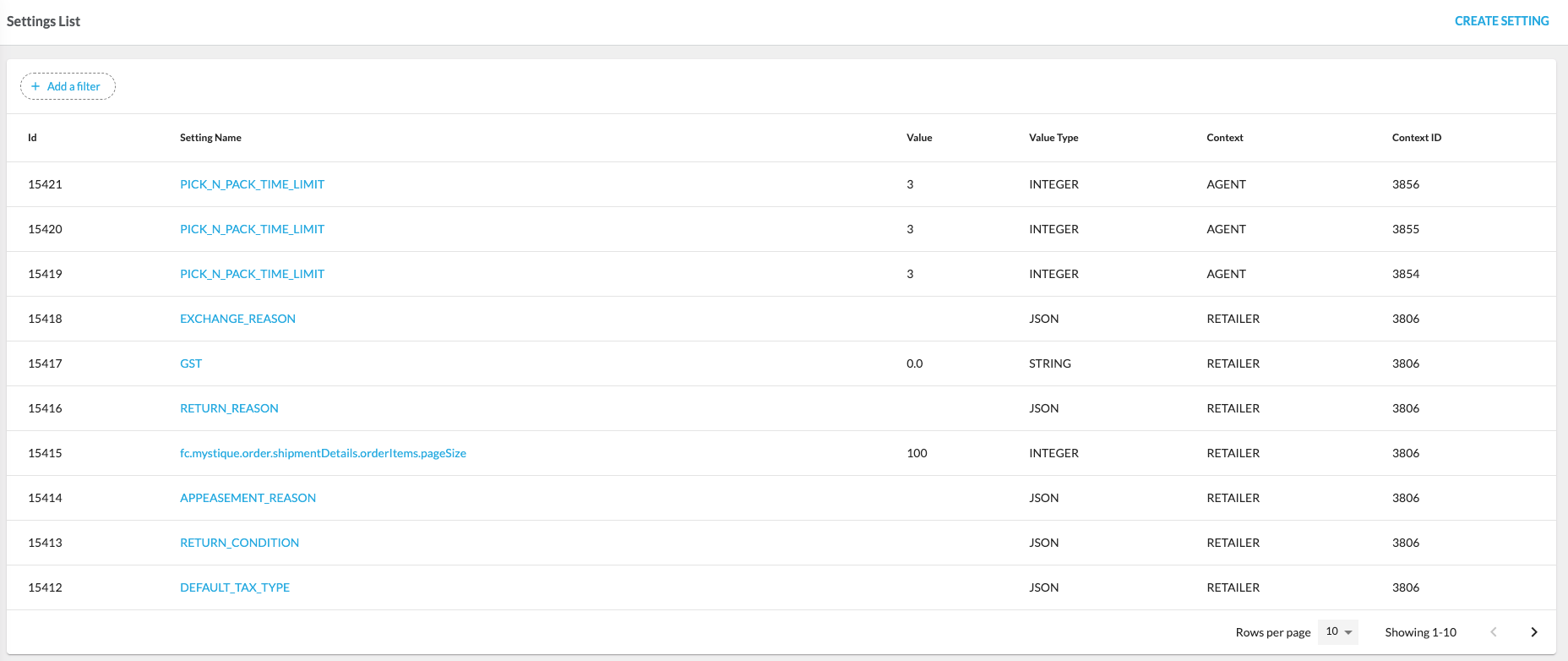

Related content
Creating and Editing Product Catalogues
Author:
Fluent Commerce
Changed on:
8 Feb 2024
Key Points
- A Product Catalogue can be created and modified via the UI.
- To create a new Product Catalogue or to edit the existing one, the user needs to have the right permissions, and the required mutations need to be enabled in the manifest.
Steps
 Prerequisites
Prerequisites
- Mutations createProductCatalogue and updateProductCatalogue are enabled in the manifest.
- The user has an assigned role with the following permissions:
- PRODCATALOGUE_VIEW
- PRODUCTCATALOGUE_CREATE
- PRODUCTCATALOGUE_UPDATE
 Creating a Product Catalogue
Creating a Product Catalogue
Step 1. Click on the CREATE CATALOGUE button on the Product Catalogues page.
Step 2. Fill in the necessary information. Some fields are mandatory. The UI will validate these fields.
Step 3. Add an attribute/attributes to a newly created Product Catalogue if necessary. Click the + ADD ATTRIBUTE button, and the Attributes form will appear.
Step 4. Click on the SUBMIT button. A new Product Catalogue is created in the System. After refreshing the page, the newly created Product Catalogue will be displayed in the Product Catalogues List.
 Editing an existing Product Catalogue
Editing an existing Product Catalogue
Step 1. Click on the EDIT button on the Product Catalogue Details page.
Step 2. Edit the Product Catalogue and click on the SUBMIT button. The drawer will close, and the update will be processed.
Related content
Create and Edit Inventory Catalogues
Author:
Fluent Commerce
Changed on:
9 Feb 2024
Key Points
- An Inventory Catalogue can be created and edited via the UI.
- To create a new Inventory Catalogue or edit an existing one, the user needs to have the right permissions, and the required mutations need to be enabled in the manifest.
Steps
 Prerequisites
Prerequisites
- Mutations createInventoryCatalogue and updateInventoryCatalogue are enabled in the manifest.
- The user has an assigned role with the following permissions:
- INVENTORYCATALOGUE_VIEW
- INVENTORYCATALOGUE_CREATE
- INVENTORYCATALOGUE_UPDATE
 Creating an Inventory Catalogue
Creating an Inventory Catalogue
Step 1. Click on the CREATE CATALOGUE button on the Inventory Catalogues page.
Step 2. Fill in the necessary information. Some fields are mandatory. The UI will validate these fields.
Step 3. Add an attribute/attributes to a newly created Inventory Catalogue if necessary. Click the + ADD ATTRIBUTE button, and the Attributes form will appear.
Step 4. Click on the SUBMIT button. A new Inventory Catalogue is created in the System. After refreshing the page, the newly created Inventory Catalogue will be displayed in the Inventory Catalogues List.
 Editing an existing Inventory Catalogue
Editing an existing Inventory Catalogue
Step 1. Click on the EDIT button on the Inventory Catalogue Details page.
Step 2. Edit the Inventory catalogue and click on the SUBMIT button. The drawer will close, and the update will be processed.
Related content
Settings Creation and Editing Mutations
Author:
Fluent Commerce
Changed on:
1 July 2024
Key Points
- A setting can be added or modified directly via UI.
- A new setting requires its name, context, the identifier of the context, the value, and the value type.
Steps
 Prerequisites:
Prerequisites:
Mutations createSetting and updateSetting are enabled in the manifest.
The user has an assigned role with the following permissions:
- SETTING_VIEW
- SETTING_CREATE
- SETTING_UPDATE
 Follow the steps to create a Setting:
Follow the steps to create a Setting:
Step 1. Click on the CREATE SETTING button on the Settings List page.
Step 2. Fill in the necessary information. Some fields are mandatory for filling, so the validation proceeds. Fields to be filled in:
- Setting name.
- The type of context. Possible values are GLOBAL, ACCOUNT, RETAILER, AGENT, CUSTOMER.
- The unique identifier of the context.
- Value.
- Value type. Possible values are BOOLEAN, INTEGER, JSON, STRING, and LOB.
Step 3. Click on the SUBMIT button. A new setting is created in the System. After refreshing the page, the newly created setting will be displayed in the Settings List.
 For editing a Setting, follow the steps:
For editing a Setting, follow the steps:
Step 1. Click on the EDIT button on the Setting Details page.
Step 2. Edit the setting and click on the SUBMIT button. The drawer will close, and the update will be processed.
Related content
User Creation and Editing Mutations
Author:
Fluent Commerce
Changed on:
30 Nov 2023
Key Points
- A user can be created and modified via UI.
- The user creation requires the associated Location, Retailer, Role, and Context. It’s also possible to add extra attributes.
- It’s only possible to ADD roles to the user on the UI. Removing roles is not feasible from the UI.
Steps
 Prerequisites:
Prerequisites:
- Mutations createUser and updateUser are enabled in the manifest.
- The user has an assigned role with the following permissions
- USER_VIEW
- USER_CREATE
- USER_UPDATE
 Follow the steps to create a User:
Follow the steps to create a User:
Step 1. Click on the CREATE USER button on the Users List page.
Step 2. Fill in the necessary information. Some fields are mandatory for filling, so the validation proceeds.
Step 3. Add a role/roles to a newly created user. Click on the + ADD ROLE button, and the Roles form will appear. To add context to a role, it is necessary to click on the + CONTEXT button, and inside the Role form, the Context form will appear.
Step 4. Adding an attribute/attribute to a newly created user is possible. In this case, one must click the + ADD ATTRIBUTE button, and the Attributes form will appear.
Step 5. Click on the SUBMIT button. A new user is created in the System. After refreshing the page, the newly created user will be displayed in the Users List.
 For editing a User, follow the steps:
For editing a User, follow the steps:
Step 1. Click on the EDIT button on the User Details page.
Step 2. While editing, adding new roles/roles to a user is possible. Click on the + ADD ROLES button, and the Roles form will appear. To add context to a role, click on the + CONTEXT button, and inside the Role form Context form will appear.
Step 3. It is possible to add new attribute/attributes to the edited user. In this case, one needs to click on the + ADD ATTRIBUTE button, and the Attributes form will appear.
Step 4. Finish editing the user and click on the SUBMIT button. The drawer will close, and the update will be processed.
Related content
Role Creation and Editing Mutations
Author:
Fluent Commerce
Changed on:
3 May 2024
Key Points
- When creating or editing roles, ensure to define permissions accurately to maintain system security.
- Follow the best practices for naming conventions and role descriptions for easier management and clarity.
- Test role changes in a controlled environment before applying them to the live system to avoid unintended access issues.
Steps
 Prerequisites:
Prerequisites:
- Mutations createRole and updateRole are enabled in the manifest.
- The user has an assigned role with the following permissions
- PERMISSION_VIEW
- ROLEPERMISSION_UPDATE
- ROLE_CREATE
- ROLE_UPDATE
- ROLE_VIEW
 Follow the steps to create a Role:
Follow the steps to create a Role:
Step 1. Click on the CREATE ROLE button on the Roles & Permissions List page.
Step 2. Fill in the necessary information. Field Name is mandatory for filling, so the validation proceeds.
Step 3. To add permissions to the created role, click the +PERMISSIONS button, and the Permissions form will appear.
Step 4. Click on the SUBMIT button. A new role is created in the System. After refreshing the page, the newly created role will be displayed in the Roles & Permissions List.
 For editing a Role, follow the steps:
For editing a Role, follow the steps:
Step 1. Click on the EDIT button on the Role Details page.
Step 2. To add permissions to the edited role, click on the +PERMISSIONS button, and the Permissions form will appear.
Step 3. Deleting a newly added permission is possible by clicking on the Remove button.
Step 4. Finish editing the role and click on the SUBMIT button. The drawer will close, and the update will be processed.No change is saved.
Related content
Control Group Creation and Editing Mutations
Author:
Fluent Commerce
Changed on:
8 Dec 2023
Key Points
- Control groups can be created and modified via the UI.
- In order to create or modify Control Groups, the user needs to have the correct permissions.
Steps
 Prerequisites
Prerequisites
- Mutations createControlGroup and updateControlGroup are enabled in the manifest.
- The user has an assigned role with the following permissions
`CONTROLGROUP_VIEW``CONTROLGROUP_CREATE``CONTROLGROUP_UPDATE`
 Follow the steps to create a Control Group:
Follow the steps to create a Control Group:
Step 1. Click on the CREATE CONTROL GROUP button on the Control Groups page.
Step 2. Fill in the necessary information. Some fields are mandatory, these fields will be validated by the UI.
Step 3. Add an attribute/attributes to a newly created Control Group if necessary. Click on the + ADD ATTRIBUTE button, and the Attributes form will appear.
Step 4. Click on the SUBMIT button. A new Control Group is created in the System. After refreshing the page, the newly created Control Group will be displayed in the Control Groups List.
 For editing a Control Group, follow the steps:
For editing a Control Group, follow the steps:
Step 1. Click on the EDIT button on the Control Group Details page.
Step 2. Edit the Control Group and click on the SUBMIT button. The drawer will close, and the update will be processed.
Related content
Virtual Catalogue Creation and Editing Mutations
Author:
Fluent Commerce
Changed on:
8 Feb 2024
Key Points
- A Virtual Catalogue can be created and modified via the UI.
- In order to create a new Virtual Catalogue or to edit the existing one, the user needs to have the right permissions, and the required mutations need to be enabled in the manifest.
Steps
 Prerequisites
Prerequisites
- Mutations createVirtualCatalogue and updateVirtualCatalogue are enabled in the manifest.
- The user has an assigned role with the following permissions:
- VIRTUALCATALOGUE_VIEW
- VIRTUALCATALOGUE_CREATE
- VIRTUALCATALOGUE_UPDATE
 Follow the steps to create a Virtual Catalogue:
Follow the steps to create a Virtual Catalogue:
Step 1. Click on the CREATE CATALOGUE button on the Virtual Catalogues page.
Step 2. Fill in the necessary information. Some fields are mandatory, these fields will be validated by the UI.
Step 3. Add an attribute/attributes to a newly created Virtual Catalogue if necessary. Click the + ADD ATTRIBUTE button, and the Attributes form will appear.
Step 4. Click on the SUBMIT button. A new Virtual Catalogue is created in the System. After refreshing the page, the newly created Virtual Catalogue will be displayed in the Virtual Catalogues List.
 For editing a Virtual Catalogue, follow the steps:
For editing a Virtual Catalogue, follow the steps:
Step 1. Click on the EDIT button on the Virtual Catalogue Details page.
Step 2. Edit the Virtual catalogue and click on the SUBMIT button. The drawer will close, and the update will be processed.
